Triflamides and Triflimides: Synthesis and Applications
Abstract
1. Introduction
2. Triflimide as a Catalyst in Organic Synthesis
3. Triflimide Derivatives in Organic Synthesis
3.1. AgNTf2
3.2. Gold Triflimide
3.3. LiNTf2, Ca(NTf2)2 and Fe(NTf2)3
4. Synthesis of Biologically Active Triflamide Derivatives
5. Triflamide Derivatives in Organic Synthesis
6. Conclusions
Author Contributions
Funding
Institutional Review Board Statement
Informed Consent Statement
Data Availability Statement
Conflicts of Interest
Sample Availability
Abbreviations
| DMEDA | 1,2-Dimethylethylenediamine |
| DMAP | 4-Dimethylaminopyridine |
| HBTU | Hexafluorophosphate Benzotriazole Tetramethyl Uronium |
| EDCl | EDC-1-Ethyl-3-(3-dimethylaminopropyl)carbodiimide |
| HOBt | Hydroxybenzotriazole |
| DIH | 1,3-Diiodo-5,5-Dimethylhydantoin |
| dF-CH3-ppy | 2-(2,4-difluorophenyl)-5-methylpyridine |
| dtbbpy | 4,4′-Di-tert-butyl-2,2′-dipyridyl |
| TTBP | Tri-Tert-Butylphenol |
| TFE | Trifluoroethanol |
| Phen | phenethylamine |
| DCE | 1,2-Dichloroethane |
| HFIP | Hexafluoroisopropanol |
| XPhos | Dicyclohexyl[2′,4′,6′-tris(propan-2-yl)[1,1′-biphenyl]-2-yl]phosphane |
| DCM | Dichloromethane |
| TEA | triethanolamine |
| Dppf | 1,1′-Bis(diphenylphosphino)ferrocene |
| Bpy | 2,2′-Bipyridine |
References
- Shainyan, B.A.; Tolstikova, L.L. Trifluoromethanesulfonamides and Related Compounds. Chem. Rev. 2013, 113, 699–733. [Google Scholar] [CrossRef] [PubMed]
- Antoniotti, S.; Dalla, V.; Duñach, E. Metal Triflimidates: Better than Metal Triflates as Catalysts in Organic Synthesis—The Effect of a Highly Delocalized Counteranion. Angew. Chem. Int. Ed. 2010, 49, 7860–7888. [Google Scholar] [CrossRef]
- Shyamsunder, A.; Beichel, W.; Klose, P.; Pang, Q.; Scherer, H.; Hoffmann, A.; Murphy, G.K.; Krossing, I.; Nazar, L.F. Inhibiting Polysulfide Shuttle in Lithium–Sulfur Batteries through Low-Ion-Pairing Salts and a Triflamide Solvent. Angew. Chem. Int. Ed. 2017, 56, 6192–6197. [Google Scholar] [CrossRef] [PubMed]
- Wabnitz, T.C.; Spencer, J.B. A General, Brønsted Acid-Catalyzed Hetero-Michael Addition of Nitrogen, Oxygen, and Sulfur Nucleophiles. Org. Lett. 2003, 5, 2141–2144. [Google Scholar] [CrossRef]
- Croft, R.A.; Mousseau, J.J.; Choi, C.; Bull, J.A. Structurally Divergent Lithium Catalyzed Friedel–Crafts Reactions on Oxetan-3-ols: Synthesis of 3,3-Diaryloxetanes and 2,3-Dihydrobenzofurans. Chem. Eur. J. 2016, 22, 16271–16276. [Google Scholar] [CrossRef] [PubMed]
- Jung, M.E.; Guzaev, M. Trimethylaluminum–Triflimide Complexes for the Catalysis of Highly Hindered Diels–Alder Reactions. Org. Lett. 2012, 14, 5169–5171. [Google Scholar] [CrossRef]
- Kano, T.; Sakamoto, R.; Yamaguchi, Y.; Itoh, K.; Maruoka, K. One-pot cross double-Mannich reaction of acetaldehyde catalyzed by a binaphthyl-based amino sulfonamide. Chem. Commun. 2013, 49, 1118–1120. [Google Scholar] [CrossRef] [PubMed]
- Fan, W.-T.; Li, N.-K.; Xu, L.; Qiao, C.; Wang, X.-W. Organo-Catalyzed Asymmetric Michael–Hemiketalization–Oxa-Pictet–Spengler Cyclization for Bridged and Spiro Heterocyclic Skeletons: Oxocarbenium Ion as a Key Intermediate. Org. Lett. 2017, 19, 6626–6629. [Google Scholar] [CrossRef]
- Parthasarathy, K.; Praveen, C.; Jeyaveeran, J.C.; Prince, A.A.M. Gold catalyzed double condensation reaction: Synthesis, antimicrobial and cytotoxicity of spirooxindole derivatives. Bioorg. Med. Chem. Lett. 2016, 26, 4310–4317. [Google Scholar] [CrossRef]
- Feng, Q.; Wu, A.; Zhang, X.; Song, L.; Sun, J. An unusual formal migrative cycloaddition of aurone-derived azadienes: Synthesis of benzofuran-fused nitrogen heterocycles. Chem. Sci. 2021, 12, 7953–7957. [Google Scholar] [CrossRef]
- Pirenne, V.; Robert, E.G.L.; Waser, J. Catalytic (3 + 2) annulation of donor–acceptor aminocyclopropane monoesters and indoles. Chem. Sci. 2021, 12, 8706–8712. [Google Scholar] [CrossRef] [PubMed]
- Wong, T.H.M.; Li, X.; Ma, D.; Sun, J. HNTf2-Catalyzed Synthesis of Hydrodibenzofurans by an Epoxidation/Semipinacol Rearrangement Cascade. Org. Lett. 2020, 22, 1951–1954. [Google Scholar] [CrossRef]
- Fan, W.-T.; Yang, X.-P.; Lv, H.-P.; Wang, X.-W.; Wang, Z. Chiral Binaphthyl Box-Copper-Catalyzed Enantioselective Tandem Michael–Ketalization Annulations for Optically Active Aryl and Heteroaryl Fused Bicyclicnonanes. Org. Lett. 2020, 22, 3936–3941. [Google Scholar] [CrossRef] [PubMed]
- Avirdi, E.; Hooshmand, S.E.; Sepahvand, H.; Vishwanathan, V.; Bahadur, I.; Katata-Seru, L.M.; Varma, R.S. Ionic liquids-assisted greener preparation of silver nanoparticles. Curr. Opin. Green Sustain. Chem. 2022, 33, 100581. [Google Scholar] [CrossRef]
- Tohidi, M.; Ghanbari, A.; Honarasa, F. Synthesis of Copper and Silver Nanoparticles by Using Microwave-Assisted Ionic Liquid Crystal Method and Their Application for Nonenzymatic Hydrogen Peroxide Determination. Electrocatalysis 2021, 12, 350–361. [Google Scholar] [CrossRef]
- De Jesus, K.; Rodriguez, R.; Baek, D.L.; Fox, R.V.; Pashikanti, S.; Sharma, K. Extraction of lanthanides and actinides present in spent nuclear fuel and in electronic waste. J. Mol. Liq. 2021, 336, 116006. [Google Scholar] [CrossRef]
- Gujar, R.B.; Yadav, A.G.; Mohapatra, P.K.; Valsala, T.P.; Sathe, D.B.; Bhatt, R.B.; Verboom, W. Comparative uptake studies on trivalent f-cations from acidic feeds using two extraction chromatography resins containing a diglycolamide in molecular diluent and ionic liquid. J. Chromatogr. A 2021, 1641, 461999. [Google Scholar] [CrossRef]
- Zhao, W.; Sun, J. Triflimide (HNTf2) in Organic Synthesis. Chem. Rev. 2018, 118, 10349–10392. [Google Scholar] [CrossRef]
- Zheng, H.; Dong, K.; Wherritt, D.; Arman, H.; Doyle, M.P. Brønsted Acid Catalyzed Friedel–Crafts-Type Coupling and Dedinitrogenation Reactions of Vinyldiazo Compounds. Angew. Chem. Int. Ed. 2020, 59, 13613–13617. [Google Scholar] [CrossRef]
- Liu, M.; Zhang, J.; Zhou, H.; Yang, H.; Xia, C.; Jiang, G. Efficient hydroarylation and hydroalkenylation of vinylarenes by Brønsted acid catalysis. RSC Adv. 2016, 6, 76780–76784. [Google Scholar] [CrossRef]
- Reddel, J.C.T.; Wang, W.; Koukounas, K.; Thomson, R.J. Triflimide-catalyzed allylsilane annulations of benzylic alcohols for the divergent synthesis of indanes and tetralins. Chem. Sci. 2017, 8, 2156–2160. [Google Scholar] [CrossRef] [PubMed]
- Zheng, H.; Wang, K.; De Angelis, L.; Arman, H.D.; Doyle, M.P. Brønsted Acid Catalyzed Oxocarbenium-Olefin Metathesis/Rearrangements of 1H-Isochromene Acetals with Vinyl Diazo Compounds. J. Am. Chem. Soc. 2021, 143, 15391–15399. [Google Scholar] [CrossRef] [PubMed]
- Zheng, H.; Wang, K.; Faghihi, I.; Griffith, W.P.; Arman, H.; Doyle, M.P. Diverse Reactions of Vinyl Diazo Compounds with Quinone Oxonium Ions, Quinone Imine Ketals, and Eschenmoser’s Salt. ACS Catal. 2021, 11, 9869–9874. [Google Scholar] [CrossRef]
- Hu, W.; Zhang, F.; Chen, C.; Qi, T.; Shen, Y.; Qian, G.; Rong, Z. Metal-free C8–H functionalization of quinoline N-oxides with ynamides. Chem. Commun. 2021, 57, 6995–6998. [Google Scholar] [CrossRef]
- Wang, Y.; Song, L.-J.; Zhang, X.; Sun, J. Metal-Free [2 + 2 + 2] Cycloaddition of Ynamides and Nitriles: Mild and Regioselective Synthesis of Fully Substituted Pyridines. Angew. Chem. Int. Ed. 2016, 55, 9704–9708. [Google Scholar] [CrossRef]
- Zhao, W.; Qian, H.; Li, Z.; Sun, J. Catalytic Ring Expansion of Cyclic Hemiaminals for the Synthesis of Medium-Ring Lactams. Angew. Chem. Int. Ed. 2015, 54, 10005–10008. [Google Scholar] [CrossRef]
- Rathod, J.; Sharma, B.M.; Mali, P.S.; Kumar, P. Tf2NH-Catalyzed 1,6-Conjugate Addition of Vinyl Azides with p-Quinone Methides: A Mild and Efficient Method for the Synthesis of β-Bis-Arylamides. Synthesis 2017, 49, 5224–5230. [Google Scholar] [CrossRef]
- Gandamana, D.A.; Gagosz, F.; Chiba, S. Diastereoselective hydroalkylation of aryl alkenes enabled by Remote hydride transfer. Tetrahedron 2020, 76, 131272. [Google Scholar] [CrossRef]
- Zhang, Y.-Q.; Zhu, X.-Q.; Chen, Y.-B.; Tan, T.-D.; Yang, M.-Y.; Ye, L.-W. Synthesis of Isothiochroman-3-ones via Metal-Free Oxidative Cyclization of Alkynyl Thioethers. Org. Lett. 2018, 20, 7721–7725. [Google Scholar] [CrossRef]
- Zhang, Y.-Q.; Zhu, X.-Q.; Xu, Y.; Bu, H.-Z.; Wang, J.-L.; Zhai, T.-Y.; Zhou, J.-M.; Ye, L.-W. Synthesis of functionalized 3-isochromanones via metal-free intramolecular alkoxylation-initiated cascade cyclization. Green Chem. 2019, 21, 3023–3028. [Google Scholar] [CrossRef]
- Li, L.; Zhu, X.-Q.; Zhang, Y.-Q.; Bu, H.-Z.; Yuan, P.; Chen, J.; Su, J.; Deng, X.; Ye, L.-W. Metal-free alkene carbooxygenation following tandem intramolecular alkoxylation/Claisen rearrangement: Stereocontrolled access to bridged[4.2.1]lactones. Chem. Sci. 2019, 10, 3123–3129. [Google Scholar] [CrossRef] [PubMed]
- Zhou, B.; Zhang, Y.-Q.; Zhang, K.; Yang, M.-Y.; Chen, Y.-B.; Li, Y.; Peng, Q.; Zhu, S.-F.; Zhou, Q.-L.; Ye, L.-W. Stereoselective synthesis of medium lactams enabled by metal-free hydroalkoxylation/stereospecific[1,3]-rearrangement. Nat. Commun. 2019, 10, 3234. [Google Scholar] [CrossRef] [PubMed]
- Bu, H.-Z.; Li, H.-H.; Luo, W.-F.; Luo, C.; Qian, P.-C.; Ye, L.-W. Synthesis of 2H-Chromenes via Unexpected [4 + 2] Annulation of Alkynyl Thioethers with o-Hydroxybenzyl Alcohols. Org. Lett. 2020, 22, 648–652. [Google Scholar] [CrossRef] [PubMed]
- Zhang, L.-B.; Wang, Z.-C.; Sun, S.-Z.; Ni, S.-F.; Wen, L.-R.; Li, M. Metal-Free Catalyzed Cyclization of N-Methoxybenzamides to Construct Quaternary Carbon-Containing Isoindolinones. Chin. J. Chem. 2021, 39, 903–908. [Google Scholar] [CrossRef]
- Abdul-Rashed, S.; Alachouzos, G.; Brennessel, W.W.; Frontier, A.J. One-Pot Double-Annulation Strategy for the Synthesis of Unusual Fused Bis-Heterocycles. Org. Lett. 2020, 22, 4350–4354. [Google Scholar] [CrossRef]
- Wang, S.; Force, G.; Carpentier, J.-F.; Sarazin, Y.; Bour, C.; Gandon, V.; Lebœuf, D. Modular Synthesis of 9,10-Dihydroacridines through an ortho-C Alkenylation/Hydroarylation Sequence between Anilines and Aryl Alkynes in Hexafluoroisopropanol. Org. Lett. 2021, 23, 2565–2570. [Google Scholar] [CrossRef]
- Li, J.; Liu, S.; Zhong, R.; Yang, Y.; He, Y.; Yang, J.; Ma, Y.; Wang, Z. Reversal of Regioselectivity in Nucleophilic Difluoroalkylation of α,β-Enones Employing In Situ-Formed Sterically Encumbered Silylium Catalyst. Org. Lett. 2021, 23, 5859–5864. [Google Scholar] [CrossRef]
- Zhang, S.-L.; Lu, Y.; Li, Y.-H.; Wang, K.-Y.; Chen, J.-H.; Yang, Z. Catalytic and Enantioselective Diels–Alder Reactions of (E)-4-Oxopent-2-enoates. Org. Lett. 2017, 19, 3986–3989. [Google Scholar] [CrossRef]
- Buttard, F.; Berthonneau, C.; Hiebel, M.-A.; Brière, J.-F.; Suzenet, F. Organocatalytic aza-Michael Reaction to 3-Vinyl-1,2,4-triazines as a Valuable Bifunctional Platform. J. Org. Chem. 2019, 84, 3702–3714. [Google Scholar] [CrossRef]
- Liu, S.; Zang, Y.; Huang, H.; Sun, J. In(OTf)3-Catalyzed Synthesis of 2,3-Dihydro-1H-benzo[e]indoles and 2,3-Dihydrobenzofurans via [3 + 2] Annulation. Org. Lett. 2020, 22, 8219–8223. [Google Scholar] [CrossRef]
- Laws, S.W.; Howard, S.Y.; Mato, R.; Meng, S.; Fettinger, J.C.; Shaw, J.T. Organocatalytic Mukaiyama Mannich Reactions of 2,5-Bis(trimethylsilyloxy)furan. Org. Lett. 2019, 21, 5073–5077. [Google Scholar] [CrossRef] [PubMed]
- Qi, C.; Yang, S.; Gandon, V.; Lebœuf, D. Calcium(II)- and Triflimide-Catalyzed Intramolecular Hydroacyloxylation of Unactivated Alkenes in Hexafluoroisopropanol. Org. Lett. 2019, 21, 7405–7409. [Google Scholar] [CrossRef]
- Xu, X.; Shao, J.; Wang, S.R. Tuning the Cyclopropane Ring-Opening Reaction over Electronic Bias by Fusion to a Pre-Aromatic Ring: TfOH-Promoted Aromatization of Dibenzonorcaradienes to Dibenzo[f,h]isocoumarins. J. Org. Chem. 2022, 87, 3794–3798. [Google Scholar] [CrossRef] [PubMed]
- Mahender Reddy, K.; Thirupathi, B.; Corey, E.J. Useful Applications of Enantioselective (4 + 2)-Cycloaddition Reactions to the Synthesis of Chiral 1,2-Amino Alcohols, 1,2-Diamines, and β-Amino Acids. Org. Lett. 2017, 19, 4956–4959. [Google Scholar] [CrossRef] [PubMed]
- Kaldre, D.; Klose, I.; Maulide, N. Stereodivergent synthesis of 1,4-dicarbonyls by traceless charge–accelerated sulfonium rearrangement. Science 2018, 361, 664–667. [Google Scholar] [CrossRef] [PubMed]
- Gati, W.; Yamamoto, H. A highly diastereoselective “super silyl” governed aldol reaction: Synthesis of α,β-dioxyaldehydes and 1,2,3-triols. Chem. Sci. 2016, 7, 394–399. [Google Scholar] [CrossRef]
- Bae, H.Y.; List, B. Triflimide: An Overlooked High-Performance Catalyst of the Mukaiyama Aldol Reaction of Silyl Ketene Acetals with Ketones. Chem. Eur. J. 2018, 24, 13767–13772. [Google Scholar] [CrossRef]
- Britten, T.K.; McLaughlin, M.G. Brønsted Acid Catalyzed Peterson Olefinations. J. Org. Chem. 2020, 85, 301–305. [Google Scholar] [CrossRef]
- Yang, L.; Fan, W.-X.; Lin, E.; Tan, D.-H.; Li, Q.; Wang, H. Synthesis of α-CF3 and α-CF2H amines via the aminofluorination of fluorinated alkenes. Chem. Commun. 2018, 54, 5907–5910. [Google Scholar] [CrossRef]
- Heerdegen, D.; Junker, J.; Dittrich, S.; Mayer, P.; Bracher, F. Traceless Isoprenylation of Aldehydes via N-Boc-N-(1,1-dimethylallyl)hydrazones. Eur. J. Org. Chem. 2020, 2020, 3680–3687. [Google Scholar] [CrossRef]
- Zhang, F.-L.; Zhu, X.; Chiba, S. Tf2NH-Catalyzed Amide Synthesis from Vinyl Azides and Alcohols. Org. Lett. 2015, 17, 3138–3141. [Google Scholar] [CrossRef] [PubMed]
- Dittrich, S.; Bracher, F. Triflimide-Catalysed Rearrangement of N-(1-Trimethylsilyl)allylhydrazones Results in the Formation of Vinylsilanes and Cyclopropanes. Eur. J. Org. Chem. 2015, 2015, 8024–8033. [Google Scholar] [CrossRef]
- Obradors, C.; List, B. Azine Activation via Silylium Catalysis. J. Am. Chem. Soc. 2021, 143, 6817–6822. [Google Scholar] [CrossRef] [PubMed]
- Mase, N.; Moniruzzaman; Yamamoto, S.; Sato, K.; Narumi, T.; Yanai, H. Epimerization-suppressed organocatalytic synthesis of poly-l-lactide in supercritical carbon dioxide under plasticizing conditions. Tetrahedron Lett. 2019, 60, 150987. [Google Scholar] [CrossRef]
- Shoji, T.; Fukushima, K.; Menjo, T.; Yamada, Y.; Hanasaki, T.; Kikushima, K.; Takenaga, N.; Dohi, T. Triflimide-Promoted Nucleophilic C-Arylation of Halopurines to Access N7-Substituted Purine Biaryls. Chem. Pharm. Bull. 2021, 69, 886–891. [Google Scholar] [CrossRef]
- Wang, B.; Gandamana, D.A.; Gagosz, F.; Chiba, S. Diastereoselective Intramolecular Hydride Transfer under Brønsted Acid Catalysis. Org. Lett. 2019, 21, 2298–2301. [Google Scholar] [CrossRef]
- Ponra, S.; Vitale, M.R.; Michelet, V.; Ratovelomanana-Vidal, V. Practical synthesis of polysubstituted naphthalene derivatives via HNTf2-catalyzed benzannulation reaction. Arkivoc 2015, 2016, 62–81. [Google Scholar] [CrossRef]
- Ponra, S.; Vitale, M.R.; Michelet, V.; Ratovelomanana-Vidal, V. HNTf2-Catalyzed Regioselective Preparation of Polysubstituted Naphthalene Derivatives Through Alkyne–Aldehyde Coupling. J. Org. Chem. 2015, 80, 3250–3257. [Google Scholar] [CrossRef]
- Arihara, R.; Kakita, K.; Suzuki, N.; Nakamura, S.; Hashimoto, S. Glycosylation with 2-Acetamido-2-deoxyglycosyl Donors at a Low Temperature: Scope of the Non-Oxazoline Method. J. Org. Chem. 2015, 80, 4259–4277. [Google Scholar] [CrossRef]
- Ohura, A.; Itoh, T.; Ishida, H.; Saito, A.; Yamamoto, K. Three-Component Regioselective Synthesis of Tetrahydrofuro[2,3-d]oxazoles and Their Efficient Conversion to Oxazoles. Asian J. Org. Chem. 2017, 6, 673–676. [Google Scholar] [CrossRef]
- Zhang, T.; Wang, Z.; Hu, X.; Yu, M.; Deng, T.; Li, G.; Lu, H. Cesium Carboxylate-Promoted Iridium Catalyzed C–H Amidation/Cyclization with 2,2,2-Trichloroethoxycarbonyl Azide. J. Org. Chem. 2016, 81, 4898–4905. [Google Scholar] [CrossRef] [PubMed]
- Zhang, W.; Yang, D.; Wang, W.; Wang, S.; Zhao, H. Iridium(III)-Catalyzed Directed ortho-C(sp2)–H Amidation of Arenes with Sulfonamides. Eur. J. Org. Chem. 2018, 2018, 2071–2077. [Google Scholar] [CrossRef]
- Woźniak, Ł.; Cramer, N. Atropo-Enantioselective Oxidation-Enabled Iridium(III)-Catalyzed C−H Arylations with Aryl Boronic Esters. Angew. Chem. Int. Ed. 2021, 60, 18532–18536. [Google Scholar] [CrossRef] [PubMed]
- Nechaev, A.A.; Van Hecke, K.; Zaman, M.; Kashtanov, S.; Ungur, L.; Pereshivko, O.P.; Peshkov, V.A.; Van der Eycken, E.V. Gold-Catalyzed Post-Ugi Ipso-Cyclization with Switchable Diastereoselectivity. J. Org. Chem. 2018, 83, 8170–8182. [Google Scholar] [CrossRef]
- Sharma, B.M.; Rathod, J.; Gonnade, R.G.; Kumar, P. Harnessing Nucleophilicity of Allenol Ester with p-Quinone Methides via Gold Catalysis: Application to the Synthesis of Diarylmethine-Substituted Enones. J. Org. Chem. 2018, 83, 9353–9363. [Google Scholar] [CrossRef]
- Demmer, C.S.; Voituriez, A.; Marinetti, A. Catalytic uses of helicenes displaying phosphorus functions. C. R. Chim. 2017, 20, 860–879. [Google Scholar] [CrossRef]
- Hu, B.; Li, J.; Cao, W.; Lin, Q.; Yang, J.; Lin, L.; Liu, X.; Feng, X. Asymmetric Synthesis of Fused Bicyclic N,O- and O,O-Acetals via Cascade Reaction by Gold(I)/N,N′-Dioxide-Nickel(II) Bimetallic Relay Catalysis. Adv. Synth. Catal. 2018, 360, 2831–2835. [Google Scholar] [CrossRef]
- Nejrotti, S.; Ghinato, S.; Gini, E.C.; Scarpi, D.; Occhiato, E.G.; Maranzana, A.; Prandi, C. Gold(I)-Catalysed Hydroarylation of Lactam-Derived Enynes as an Entry to Tetrahydrobenzo[g]quinolines. Eur. J. Org. Chem. 2020, 2020, 646–653. [Google Scholar] [CrossRef]
- Liu, C.; Yang, F. Au-Catalyzed Stereoselective Ritter Reaction of Haloalkynes with Nitriles for (Z)-β-Halogenated Enamides. Eur. J. Org. Chem. 2019, 2019, 6867–6870. [Google Scholar] [CrossRef]
- Singh, R.R.; Skaria, M.; Chen, L.-Y.; Cheng, M.-J.; Liu, R.-S. Gold-catalyzed (4 + 3)-annulations of 2-alkenyl-1-alkynylbenzenes with anthranils with alkyne-dependent chemoselectivity: Skeletal rearrangement versus non-rearrangement. Chem. Sci. 2019, 10, 1201–1206. [Google Scholar] [CrossRef]
- Kardile, R.D.; Chao, T.-H.; Cheng, M.-J.; Liu, R.-S. Gold(I)-Catalyzed Highly Diastereo- and Enantioselective Cyclization–[4+3] Annulation Cascades between 2-(1-Alkynyl)-2-alken-1-ones and Anthranils. Angew. Chem. Int. Ed. 2020, 59, 10396–10400. [Google Scholar] [CrossRef] [PubMed]
- Delgado-Rebollo, M.; García-Morales, C.; Maya, C.; Prieto, A.; Echavarren, A.M.; Pérez, P.J. Coinage metal complexes bearing fluorinated N-Heterocyclic carbene ligands. J. Organomet. Chem. 2019, 898, 120856. [Google Scholar] [CrossRef]
- Laha, D.; Meher, K.B.; Bankar, O.S.; Bhat, R.G. Silver-Catalyzed One-Pot Access to Diastereoselective Benzo[5,6]oxepino[2,3-c]pyrroles via Formal (5 + 2)-Annulation of Donor-/Acceptor-Type Aryl Vinyl diazosuccinimide with Ketones. Asian J. Org. Chem. 2022, 11, e202200062. [Google Scholar] [CrossRef]
- Racys, D.T.; Sharif, S.A.I.; Pimlott, S.L.; Sutherland, A. Silver(I)-Catalyzed Iodination of Arenes: Tuning the Lewis Acidity of N-Iodosuccinimide Activation. J. Org. Chem. 2016, 81, 772–780. [Google Scholar] [CrossRef] [PubMed]
- Zhang, X.; Sun, X.; Fan, H.; Li, P.; Lyu, C.; Rao, W. Gold-Catalyzed Chemoselective Synthesis of Heterocycles from 3-(2-Azidophenyl)prop-2-yn-1-ols and Aldehydes. Eur. J. Org. Chem. 2016, 2016, 4265–4268. [Google Scholar] [CrossRef]
- Lonca, G.H.; Tejo, C.; Chan, H.L.; Chiba, S.; Gagosz, F. Gold(i)-catalyzed 6-endo-dig azide–yne cyclization: Efficient access to 2H-1,3-oxazines. Chem. Commun. 2017, 53, 736–739. [Google Scholar] [CrossRef]
- Shen, C.-H.; Pan, Y.; Yu, Y.-F.; Wang, Z.-S.; He, W.; Li, T.; Ye, L.-W. Facile and efficient synthesis of [1,4]oxazino[3,2-b]indoles and 1H-pyrazino[2,3-b]indoles through gold-catalyzed cascade cyclization of (azido)ynamides. J. Organomet. Chem. 2015, 795, 63–67. [Google Scholar] [CrossRef]
- Shen, W.-B.; Sun, Q.; Li, L.; Liu, X.; Zhou, B.; Yan, J.-Z.; Lu, X.; Ye, L.-W. Divergent synthesis of N-heterocycles via controllable cyclization of azido-diynes catalyzed by copper and gold. Nat. Commun. 2017, 8, 1748. [Google Scholar] [CrossRef]
- Li, N.; Lian, X.-L.; Li, Y.-H.; Wang, T.-Y.; Han, Z.-Y.; Zhang, L.; Gong, L.-Z. Gold-Catalyzed Direct Assembly of Aryl-Annulated Carbazoles from 2-Alkynyl Arylazides and Alkynes. Org. Lett. 2016, 18, 4178–4181. [Google Scholar] [CrossRef]
- Galenko, A.V.; Shakirova, F.M.; Galenko, E.E.; Novikov, M.S.; Khlebnikov, A.F. Fe(II)/Au(I) Relay Catalyzed Propargylisoxazole to Pyridine Isomerization: Access to 6-Halonicotinates. J. Org. Chem. 2017, 82, 5367–5379. [Google Scholar] [CrossRef]
- Wu, Y.; Zhu, L.; Yu, Y.; Luo, X.; Huang, X. Polysubstituted 2-Aminopyrrole Synthesis via Gold-Catalyzed Intermolecular Nitrene Transfer from Vinyl Azide to Ynamide: Reaction Scope and Mechanistic Insights. J. Org. Chem. 2015, 80, 11407–11416. [Google Scholar] [CrossRef] [PubMed]
- Pawar, S.K.; Sahani, R.L.; Liu, R.-S. Diversity in Gold-Catalyzed Formal Cycloadditions of Ynamides with Azidoalkenes or 2H-Azirines: [3+2] versus [4 + 3] Cycloadditions. Chem. Eur. J. 2015, 21, 10843–10850. [Google Scholar] [CrossRef] [PubMed]
- Jin, H.; Huang, L.; Xie, J.; Rudolph, M.; Rominger, F.; Hashmi, A.S.K. Gold-Catalyzed C—H Annulation of Anthranils with Alkynes: A Facile, Flexible, and Atom-Economical Synthesis of Unprotected 7-Acylindoles. Angew. Chem. Int. Ed. 2016, 55, 794–797. [Google Scholar] [CrossRef] [PubMed]
- Zhou, A.-H.; He, Q.; Shu, C.; Yu, Y.-F.; Liu, S.; Zhao, T.; Zhang, W.; Lu, X.; Ye, L.-W. Atom-economic generation of gold carbenes: Gold-catalyzed formal [3 + 2] cycloaddition between ynamides and isoxazoles. Chem. Sci. 2015, 6, 1265–1271. [Google Scholar] [CrossRef]
- Xiao, X.-Y.; Zhou, A.-H.; Shu, C.; Pan, F.; Li, T.; Ye, L.-W. Atom-Economic Synthesis of Fully Substituted 2-Aminopyrroles via Gold-Catalyzed Formal [3 + 2] Cycloaddition between Ynamides and Isoxazoles. Chem. Asian J. 2015, 10, 1854–1858. [Google Scholar] [CrossRef]
- Giri, S.S.; Liu, R.-S. Gold-catalyzed [4 + 3]- and [4 + 2]-annulations of 3-en-1-ynamides with isoxazoles via novel 6π-electrocyclizations of 3-azahepta trienyl cations. Chem. Sci. 2018, 9, 2991–2995. [Google Scholar] [CrossRef]
- Pan, Y.; Chen, G.-W.; Shen, C.-H.; He, W.; Ye, L.-W. Synthesis of fused isoquinolines via gold-catalyzed tandem alkyne amination/intramolecular O–H insertion. Org. Chem. Front. 2016, 3, 491–495. [Google Scholar] [CrossRef]
- Shu, C.; Wang, Y.-H.; Zhou, B.; Li, X.-L.; Ping, Y.-F.; Lu, X.; Ye, L.-W. Generation of α-Imino Gold Carbenes through Gold-Catalyzed Intermolecular Reaction of Azides with Ynamides. J. Am. Chem. Soc. 2015, 137, 9567–9570. [Google Scholar] [CrossRef]
- Zhou, B.; Zhang, Y.-Q.; Liu, X.; Ye, L.-W. Gold-catalyzed intermolecular reaction of ynamides with 3-indolyl azides via an unexpected 1,2-alkyl migration. Sci. Bull. 2017, 62, 1201–1206. [Google Scholar] [CrossRef]
- Jin, H.; Tian, B.; Song, X.; Xie, J.; Rudolph, M.; Rominger, F.; Hashmi, A.S.K. Gold-Catalyzed Synthesis of Quinolines from Propargyl Silyl Ethers and Anthranils through the Umpolung of a Gold Carbene Carbon. Angew. Chem. Int. Ed. 2016, 55, 12688–12692. [Google Scholar] [CrossRef]
- González, J.; Santamaría, J.; Suárez-Sobrino, Á.L.; Ballesteros, A. One-Pot and Regioselective Gold-Catalyzed Synthesis of 2-Imidazolyl-1-pyrazolylbenzenes from 1-Propargyl-1H-benzotriazoles, Alkynes and Nitriles through α-Imino Gold(I) Carbene Complexes. Adv. Synth. Catal. 2016, 358, 1398–1403. [Google Scholar] [CrossRef]
- Allegue, D.; González, J.; Fernández, S.; Santamaría, J.; Ballesteros, A. Regiodivergent Control in the Gold(I) Catalyzed Synthesis of 7-Pyrazolylindoles from 1-Propargyl-1H-benzotriazoles and Ynamides through α-Imino Gold(I) Carbene Complexes. Adv. Synth. Catal. 2019, 361, 758–768. [Google Scholar] [CrossRef]
- Mei, L.-Y.; Wei, Y.; Tang, X.-Y.; Shi, M. Catalyst-Dependent Stereodivergent and Regioselective Synthesis of Indole-Fused Heterocycles through Formal Cycloadditions of Indolyl-Allenes. J. Am. Chem. Soc. 2015, 137, 8131–8137. [Google Scholar] [CrossRef] [PubMed]
- Ruan, P.-P.; Li, H.-H.; Liu, X.; Zhang, T.; Zuo, S.-X.; Zhu, C.; Ye, L.-W. Synthesis of α,β-Unsaturated Amidines through Gold-Catalyzed Intermolecular Reaction of Azides with Ynamides. J. Org. Chem. 2017, 82, 9119–9125. [Google Scholar] [CrossRef] [PubMed]
- Shu, C.; Wang, Y.-H.; Shen, C.-H.; Ruan, P.-P.; Lu, X.; Ye, L.-W. Gold-Catalyzed Intermolecular Ynamide Amination-Initiated Aza-Nazarov Cyclization: Access to Functionalized 2-Aminopyrroles. Org. Lett. 2016, 18, 3254–3257. [Google Scholar] [CrossRef]
- Zhai, R.L.; Xue, Y.S.; Liang, T.; Mi, J.J.; Xu, Z. Regioselective Arene and Heteroarene Functionalization: N-Alkenoxypyridinium Salts as Electrophilic Alkylating Agents for the Synthesis of α-Aryl/α-Heteroaryl Ketones. J. Org. Chem. 2018, 83, 10051–10059. [Google Scholar] [CrossRef]
- Zhou, W.; Voituriez, A. Gold(I)-Catalyzed Synthesis of Highly Substituted 1,4-Dicarbonyl Derivatives via Sulfonium (3,3)-Sigmatropic Rearrangement. Org. Lett. 2020, 23, 247–252. [Google Scholar] [CrossRef]
- Hamada, N.; Yoshida, Y.; Oishi, S.; Ohno, H. Gold-Catalyzed Cascade Reaction of Skipped Diynes for the Construction of a Cyclohepta[b]pyrrole Scaffold. Org. Lett. 2017, 19, 3875–3878. [Google Scholar] [CrossRef]
- Li, W.; Yu, B. Gold-catalyzed glycosylation in the synthesis of complex carbohydrate-containing natural products. Chem. Soc. Rev. 2018, 47, 7954–7984. [Google Scholar] [CrossRef]
- Yu, B. Gold(I)-Catalyzed Glycosylation with Glycosyl o-Alkynylbenzoates as Donors. Acc. Chem. Res. 2018, 51, 507–516. [Google Scholar] [CrossRef]
- Webster, S.; O’Rourke, K.M.; Fletcher, C.; Pimlott, S.L.; Sutherland, A.; Lee, A.-L. Rapid Iododeboronation with and without Gold Catalysis: Application to Radiolabelling of Arenes. Chem. Eur. J. 2018, 24, 937–943. [Google Scholar] [CrossRef] [PubMed]
- Liu, Y.; Wang, X.; Wang, Y.; Du, C.; Shi, H.; Jin, S.; Jiang, C.; Xiao, J.; Cheng, M. Gold(I)-Catalyzed Synthesis of Unsymmetrical Ethers Using Alcohols as Alkylating Reagents. Adv. Synth. Catal. 2015, 357, 1029–1036. [Google Scholar] [CrossRef]
- Shcherbakov, N.V.; Dar’in, D.V.; Kukushkin, V.Y.; Dubovtsev, A.Y. Gold-Catalyzed Nitrene Transfer from Benzofuroxans to N-Allylynamides: Synthesis of 3-Azabicyclo[3.1.0]hexanes. J. Org. Chem. 2021, 86, 12964–12972. [Google Scholar] [CrossRef] [PubMed]
- Huang, H.; Zhang, T.; Sun, J. Mild C–C Bond Formation via Lewis Acid Catalyzed Oxetane Ring Opening with Soft Carbon Nucleophiles. Angew. Chem. Int. Ed. 2021, 60, 2668–2673. [Google Scholar] [CrossRef] [PubMed]
- Croft, R.A.; Mousseau, J.J.; Choi, C.; Bull, J.A. Oxetane ethers are formed reversibly in the lithium-catalyzed Friedel–Crafts alkylation of phenols with oxetanols: Synthesis of dihydrobenzofurans, diaryloxetanes, and oxetane ethers. Tetrahedron 2018, 74, 5427–5435. [Google Scholar] [CrossRef]
- Schroeder, S.; Strauch, C.; Gaelings, N.; Niggemann, M. Vinyl Triflimides—A Case of Assisted Vinyl Cation Formation. Angew. Chem. Int. Ed. 2019, 58, 5119–5123. [Google Scholar] [CrossRef]
- Ochiai, M.; Okubo, T.; Miyamoto, K. Weakly Nucleophilic Conjugate Bases of Superacids as Powerful Nucleophiles in Vinylic Bimolecular Nucleophilic Substitutions of Simple β-Alkylvinyl(aryl)-λ3-bromanes. J. Am. Chem. Soc. 2011, 133, 3342–3344. [Google Scholar] [CrossRef]
- Chuchmareva, M.; Strauch, C.; Schröder, S.; Collong, A.; Niggemann, M. Regio- and Stereoselective N-addition to an Open Bromo Vinyl Cation. Tetrahedron Lett. 2021, 74, 153173. [Google Scholar] [CrossRef]
- Hao, L.; Pan, Q.; Zhang, C.; Wang, S.; Wang, W.; Zhang, J.; Bai, L.; Wang, Y. General, Straightforward, and Atom-Economical Synthesis of Vinyl Triflimides. Chem. Eur. J. 2021, 27, 12272–12275. [Google Scholar] [CrossRef]
- Dada, R.; Sulthan, M.; Yaragorla, S. Calcium-Catalyzed Stereoselective Tandem [4 + 2] and [3 + 2] Annulation Reaction for the Synthesis of Dihydropyrrolo[1,2-a]quinolines. Org. Lett. 2019, 22, 279–283. [Google Scholar] [CrossRef]
- Wang, S.; Guillot, R.; Carpentier, J.-F.; Sarazin, Y.; Bour, C.; Gandon, V.; Lebœuf, D. Synthesis of Bridged Tetrahydrobenzo[b]azepines and Derivatives through an Aza-Piancatelli Cyclization/Michael Addition Sequence. Angew. Chem. Int. Ed. 2020, 59, 1134–1138. [Google Scholar] [CrossRef] [PubMed]
- Qi, C.; Gandon, V.; Lebœuf, D. Calcium(II)-Catalyzed Alkenylation of N-Acyliminiums and Related Ions with Vinylboronic Acids. Adv. Synth. Catal. 2017, 359, 2671–2675. [Google Scholar] [CrossRef]
- Cabrero-Antonino, J.R.; Leyva-Pérez, A.; Corma, A. Iron(III) Triflimide as a Catalytic Substitute for Gold(I) in Hydroaddition Reactions to Unsaturated Carbon–Carbon Bonds. Chem. Eur. J. 2013, 19, 8627–8633. [Google Scholar] [CrossRef] [PubMed]
- Racys, D.T.; Warrilow, C.E.; Pimlott, S.L.; Sutherland, A. Highly Regioselective Iodination of Arenes via Iron(III)-Catalyzed Activation of N-Iodosuccinimide. Org. Lett. 2015, 17, 4782–4785. [Google Scholar] [CrossRef]
- Mostafa, M.A.B.; Bowley, R.M.; Racys, D.T.; Henry, M.C.; Sutherland, A. Iron(III)-Catalyzed Chlorination of Activated Arenes. J. Org. Chem. 2017, 82, 7529–7537. [Google Scholar] [CrossRef] [PubMed]
- Mostafa, M.A.B.; Calder, E.D.D.; Racys, D.T.; Sutherland, A. Intermolecular Aryl C−H Amination through Sequential Iron and Copper Catalysis. Chem. Eur. J. 2017, 23, 1044–1047. [Google Scholar] [CrossRef] [PubMed]
- Henry, M.C.; Abbinante, V.M.; Sutherland, A. Iron-Catalyzed Regioselective Synthesis of 2-Arylbenzoxazoles and 2-Arylbenzothiazoles via Alternative Reaction Pathways. Eur. J. Org. Chem. 2020, 2020, 2819–2826. [Google Scholar] [CrossRef]
- Xin, G.; Ming, Y.; Ji, C.; Wei, Z.; Li, S.; Morris-Natschke, S.L.; Zhang, X.; Yu, K.; Li, Y.; Zhang, B.; et al. Novel potent antiplatelet thrombotic agent derived from biguanide for ischemic stroke. Eur. J. Med. Chem. 2020, 200, 112462. [Google Scholar] [CrossRef]
- Markowicz-Piasecka, M.; Huttunen, J.; Zajda, A.; Sikora, J.; Huttunen, K.M. Sulfonamide metformin derivatives induce mitochondrial-associated apoptosis and cell cycle arrest in breast cancer cells. Chem.-Biol. Interact. 2022, 352, 109795. [Google Scholar] [CrossRef]
- Zajda, A.; Sikora, J.; Huttunen, K.M.; Markowicz-Piasecka, M. Structural Comparison of Sulfonamide-Based Derivatives That Can Improve Anti-Coagulation Properties of Metformin. Int. J. Mol. Sci. 2022, 23, 4132. [Google Scholar] [CrossRef]
- O’Hanlon, J.A.; Ren, X.; Morris, M.; Wong, L.L.; Robertson, J. Hydroxylation of anilides by engineered cytochrome P450BM3. Org. Biomol. Chem. 2017, 15, 8780–8787. [Google Scholar] [CrossRef] [PubMed]
- Gómez-García, O.; Gómez, E.; Monzón-González, C.; Ramírez-Apan, T.; Álvarez-Toledano, C. An Efficient Strategy for the Synthesis of 1-(Trifluoromethylsulfonamido)propan-2-yl Esters and the Evaluation of Their Cytotoxic Activity. Chem. Pharm. Bull. 2017, 65, 248–252. [Google Scholar] [CrossRef] [PubMed]
- Hong, B.-T.; Chen, C.-L.; Fang, J.-M.; Tsai, K.-C.; Wang, S.-Y.; Huang, W.-I.; Cheng, Y.-S.E.; Wong, C.-H. Oseltamivir hydroxamate and acyl sulfonamide derivatives as influenza neuraminidase inhibitors. Bioorg. Med. Chem. 2014, 22, 6647–6654. [Google Scholar] [CrossRef] [PubMed]
- Hu, Y.; Chen, B.; Lei, Z.; Zhao, H.; Zhu, H.; Quan, P.; Tian, Y. Synthesis and Biological Evaluation of NH2-Sulfonyl Oseltamivir Analogues as Influenza Neuraminidase Inhibitors. Molecules 2019, 24, 2176. [Google Scholar] [CrossRef] [PubMed]
- Wang, S.; Su, M.; Wang, J.; Li, Z.; Zhang, L.; Ji, X.; Li, J.; Li, J.; Liu, H. (R)-3-Amino-1-((3aS,7aS)-octahydro-1H-indol-1-yl)-4-(2,4,5-trifluorophenyl)butan-1-one derivatives as potent inhibitors of dipeptidyl peptidase-4: Design, synthesis, biological evaluation, and molecular modeling. Bioorg. Med. Chem. 2014, 22, 6684–6693. [Google Scholar] [CrossRef]
- Ji, Y.; Chen, X.; Chen, H.; Zhang, X.; Fan, Z.; Xie, L.; Ma, B.; Zhu, C. Designing of acyl sulphonamide based quinoxalinones as multifunctional aldose reductase inhibitors. Bioorg. Med. Chem. 2019, 27, 1658–1669. [Google Scholar] [CrossRef]
- Liedtke, A.J.; Adeniji, A.O.; Chen, M.; Byrns, M.C.; Jin, Y.; Christianson, D.W.; Marnett, L.J.; Penning, T.M. Development of Potent and Selective Indomethacin Analogues for the Inhibition of AKR1C3 (Type 5 17β-Hydroxysteroid Dehydrogenase/Prostaglandin F Synthase) in Castrate-Resistant Prostate Cancer. J. Med. Chem. 2013, 56, 2429–2446. [Google Scholar] [CrossRef]
- Nuti, E.; Cuffaro, D.; Bernardini, E.; Camodeca, C.; Panelli, L.; Chaves, S.; Ciccone, L.; Tepshi, L.; Vera, L.; Orlandini, E.; et al. Development of Thioaryl-Based Matrix Metalloproteinase-12 Inhibitors with Alternative Zinc-Binding Groups: Synthesis, Potentiometric, NMR, and Crystallographic Studies. J. Med. Chem. 2018, 61, 4421–4435. [Google Scholar] [CrossRef]
- Newcombe, S.; Bobin, M.; Shrikhande, A.; Gallop, C.; Pace, Y.; Yong, H.; Gates, R.; Chaudhuri, S.; Roe, M.; Hoffmann, E.; et al. Gold amides as anticancer drugs: Synthesis and activity studies. Org. Biomol. Chem. 2013, 11, 3255–3260. [Google Scholar] [CrossRef]
- Renard, J.-F.; Lecomte, F.; Hubert, P.; de Leval, X.; Pirotte, B. N-(3-Arylaminopyridin-4-yl)alkanesulfonamides as pyridine analogs of nimesulide: Cyclooxygenases inhibition, anti-inflammatory studies and insight on metabolism. Eur. J. Med. Chem. 2014, 74, 12–22. [Google Scholar] [CrossRef]
- Skerratt, S.E.; de Groot, M.J.; Phillips, C. Discovery of a novel binding pocket for CYP 2C9 inhibitors: Crystallography, pharmacophore modelling and inhibitor SAR. Med. Chem. Commun. 2016, 7, 813–819. [Google Scholar] [CrossRef]
- Suthagar, K.; Polson, M.I.J.; Fairbanks, A.J. Unexpected furanose/pyranose equilibration of N-glycosyl sulfonamides, sulfamides and sulfamates. Org. Biomol. Chem. 2015, 13, 6573–6579. [Google Scholar] [CrossRef] [PubMed]
- Winton, V.J.; Aldrich, C.; Kiessling, L.L. Carboxylate Surrogates Enhance the Antimycobacterial Activity of UDP-Galactopyranose Mutase Probes. ACS Infect. Dis. 2016, 2, 538–543. [Google Scholar] [CrossRef]
- Zhao, A.; Li, Y.; Orahoske, C.M.; Schnur, B.; Sabbagh, A.; Zhang, W.; Li, B.; Su, B. Lead optimization of selective tubulin inhibitors as anti-trypanosomal agents. Bioorg. Med. Chem. 2019, 27, 1517–1528. [Google Scholar] [CrossRef] [PubMed]
- Steverding, D.; Tyler, K.M. Novel antitrypanosomal agents. Expert Opin. Investig. Drugs 2005, 14, 939–955. [Google Scholar] [CrossRef] [PubMed]
- Yang, X.; Pang, X.; Fan, L.; Li, X.; Chen, Y. Synthesis and evaluation of sulfonamide derivatives as potent Human Uric Acid Transporter 1 (hURAT1) inhibitors. Bioorg. Med. Chem. Lett. 2017, 27, 1919–1922. [Google Scholar] [CrossRef] [PubMed]
- Rafique, R.; Khan, K.M.; Chigurupati, S.; Wadood, A.; Rehman, A.U.; Salar, U.; Venugopal, V.; Shamim, S.; Taha, M.; Perveen, S. Synthesis, in vitro α-amylase inhibitory, and radicals (DPPH & ABTS) scavenging potentials of new N-sulfonohydrazide substituted indazoles. Bioorg. Chem. 2020, 94, 103410. [Google Scholar] [CrossRef]
- Dunn, D.; Iqbal, M.; Chatterjee, S. Synthesis and activity of proteasome inhibitors. J. Enzyme Inhib. Med. Chem. 2014, 29, 55–58. [Google Scholar] [CrossRef][Green Version]
- Kumari, G.; Singh, R.K. Molecular Modeling, Synthesis, and Anti-HIV Activity of Novel Isoindolinedione Analogues as Potent Non-nucleoside Reverse Transcriptase Inhibitors. Chem. Biol. Drug Des. 2016, 87, 200–212. [Google Scholar] [CrossRef]
- Yanai, K.; Togo, H. Preparation of phenanthridines from N-(o-arylbenzyl)trifluoromethanesulfonamides with 1,3-diiodo-5,5-dimethylhydantoin. Tetrahedron 2020, 76, 131503. [Google Scholar] [CrossRef]
- Huang, G.; Solano, C.M.; Su, Y.; Ezzat, N.; Matsui, S.; Huang, L.; Chakrabarti, D.; Yuan, Y. Microwave-assisted, rapid synthesis of 2-vinylquinolines and evaluation of their antimalarial activity. Tetrahedron Lett. 2019, 60, 1736–1740. [Google Scholar] [CrossRef] [PubMed]
- Takeshima, A.; Kano, T.; Maruoka, K. Synthesis of Phenylcyclopropane-Based Secondary Amine Catalysts and Their Applications in Enamine Catalysis. Org. Lett. 2019, 21, 8071–8074. [Google Scholar] [CrossRef] [PubMed]
- Yang, X.; Xie, Z.; Li, Y.; Zhang, Y.-Q. Enantioselective aerobic oxidative cross-dehydrogenative coupling of glycine derivatives with ketones and aldehydes via cooperative photoredox catalysis and organocatalysis. Chem. Sci. 2020, 11, 4741–4746. [Google Scholar] [CrossRef] [PubMed]
- Gorde, A.B.; Ramapanicker, R. d-Prolyl-2-(trifluoromethylsulfonamidopropyl)pyrrolidine: An Organocatalyst for Asymmetric Michael Addition of Aldehydes to β-Nitroalkenes at Ambient Conditions. J. Org. Chem. 2019, 84, 1523–1533. [Google Scholar] [CrossRef]
- Skrzyńska, A.; Frankowski, S.; Topolska, A.; Dyguda, M.; Gao, X.-Y.; Xu, C.-J.; Chen, Y.-C.; Albrecht, Ł. Enantioselective H-bond-directed vinylogous iminium ion strategy for the functionalization of vinyl-substituted heteroaryl aldehydes. Chem. Commun. 2021, 57, 1667–1670. [Google Scholar] [CrossRef]
- Ramchandra, G.T. Synthesis of Axially Chiral Amines and its Application in Asymmetric Catalysis. IJRAR Int. J. Res. Anal. Rev. 2019, 6, 392y–408y. [Google Scholar]
- Schwengers, S.A.; De, C.K.; Grossmann, O.; Grimm, J.A.A.; Sadlowski, N.R.; Gerosa, G.G.; List, B. Unified Approach to Imidodiphosphate-Type Brønsted Acids with Tunable Confinement and Acidity. J. Am. Chem. Soc. 2021, 143, 14835–14844. [Google Scholar] [CrossRef]
- Yuan, Y.-H.; Han, X.; Zhu, F.-P.; Tian, J.-M.; Zhang, F.-M.; Zhang, X.-M.; Tu, Y.-Q.; Wang, S.-H.; Guo, X. Development of bifunctional organocatalysts and application to asymmetric total synthesis of naucleofficine I and II. Nat. Commun. 2019, 10, 3394. [Google Scholar] [CrossRef]
- Suto, T.; Yanagita, Y.; Nagashima, Y.; Takikawa, S.; Kurosu, Y.; Matsuo, N.; Miura, K.; Simizu, S.; Sato, T.; Chida, N. Unified Total Synthesis of Madangamine Alkaloids. Bull. Chem. Soc. Jpn. 2019, 92, 545–571. [Google Scholar] [CrossRef]
- Ashley, M.A.; Yamauchi, C.; Chu, J.C.K.; Otsuka, S.; Yorimitsu, H.; Rovis, T. Photoredox-Catalyzed Site-Selective α-C(sp3)−H Alkylation of Primary Amine Derivatives. Angew. Chem. Int. Ed. 2019, 58, 4002–4006. [Google Scholar] [CrossRef]
- Vuillermet, F.; Bourret, J.; Pelletier, G. Synthesis of Imidazo[1,2-a]pyridines: Triflic Anhydride-Mediated Annulation of 2H-Azirines with 2-Chloropyridines. J. Org. Chem. 2021, 86, 388–402. [Google Scholar] [CrossRef] [PubMed]
- Kawamoto, T.; Ikawa, K.; Kamimura, A. One-Pot Synthesis of CF3-Substituted Vinyl Trifluoromethanesulfonamides from Imines and Trifluoromethanesulfonic Anhydride. J. Org. Chem. 2021, 86, 15818–15824. [Google Scholar] [CrossRef] [PubMed]
- Dreier, P.; Pipertzis, A.; Spyridakou, M.; Mathes, R.; Floudas, G.; Frey, H. Introduction of Trifluoromethanesulfonamide Groups in Poly(ethylene oxide): Ionic Conductivity of Single-Ion-Conducting Block Copolymer Electrolytes. Macromolecules 2022, 55, 1342–1353. [Google Scholar] [CrossRef]
- Velasco-Rubio, Á.; Varela, J.A.; Saá, C. Palladium-Catalyzed [5 + 2] Heteroannulation of Phenethylamides with 1,3-Dienes to Dopaminergic 3-Benzazepines. Org. Lett. 2020, 22, 3591–3595. [Google Scholar] [CrossRef] [PubMed]
- Markus, A.; Schepmann, D.; Wünsch, B. Synthesis of oxazolo-annulated 3-benzazepines designed by merging two negative allosteric NMDA receptor modulators. Arch. Pharm. 2022, 355, 2200020. [Google Scholar] [CrossRef]
- Li, X.; Peters, B.B.C.; Tan, M.; He, L.; Yang, J.; Andersson, P.G.; Zhou, T. Mono-N-Alkylation of Sulfonamides with Alcohols Catalyzed by Iridium N-Heterocyclic Carbene-Phosphine Complexes. Asian J. Org. Chem. 2022, 11, e202200178. [Google Scholar] [CrossRef]
- Wang, N.; Liu, L.; Xu, W.; Zhang, M.; Huang, Z.; Shi, D.; Zhao, Y. Rhodium(III)-Catalyzed Oxidative Annulation of Ketoximes with Sulfonamide: A Direct Approach to Indazoles. Org. Lett. 2019, 21, 365–368. [Google Scholar] [CrossRef]
- Li, Z.; Zhang, H.; Yu, S. NaClO-Promoted Atroposelective Couplings of 3-Substituted Indoles with Amino Acid Derivatives. Org. Lett. 2019, 21, 4754–4758. [Google Scholar] [CrossRef]
- Yang, M.; Su, B.; Wang, Y.; Chen, K.; Jiang, X.; Zhang, Y.-F.; Zhang, X.-S.; Chen, G.; Cheng, Y.; Cao, Z.; et al. Silver-catalysed direct amination of unactivated C–H bonds of functionalized molecules. Nat. Commun. 2014, 5, 4707. [Google Scholar] [CrossRef]
- Moskalik, M.Y.; Garagan, I.A.; Astakhova, V.V.; Sterkhova, I.V.; Shainyan, B.A. Solvent-dependent oxidative triflamidation of alkenes and N(O)-Heterocyclization of the products. Tetrahedron 2021, 88, 132145. [Google Scholar] [CrossRef]
- Moskalik, M.Y.; Shainyan, B.A.; Ushakov, I.A.; Sterkhova, I.V.; Astakhova, V.V. Oxidant effect, skeletal rearrangements and solvent interception in oxidative triflamidation of norbornene and 2,5-norbornadiene. Tetrahedron 2020, 76, 131018. [Google Scholar] [CrossRef]
- Shainyan, B.A.; Moskalik, M.Y.; Astakhova, V.V.; Schilde, U. Novel design of 3,8-diazabicyclo[3.2.1]octane framework in oxidative sulfonamidation of 1,5-hexadiene. Tetrahedron 2014, 70, 4547–4551. [Google Scholar] [CrossRef]
- Moskalik, M.Y.; Astakhova, V.V.; Schilde, U.; Sterkhova, I.V.; Shainyan, B.A. Assembling of 3,6-diazabicyclo[3.1.0]hexane framework in oxidative triflamidation of substituted buta-1,3-dienes. Tetrahedron 2014, 70, 8636–8641. [Google Scholar] [CrossRef]
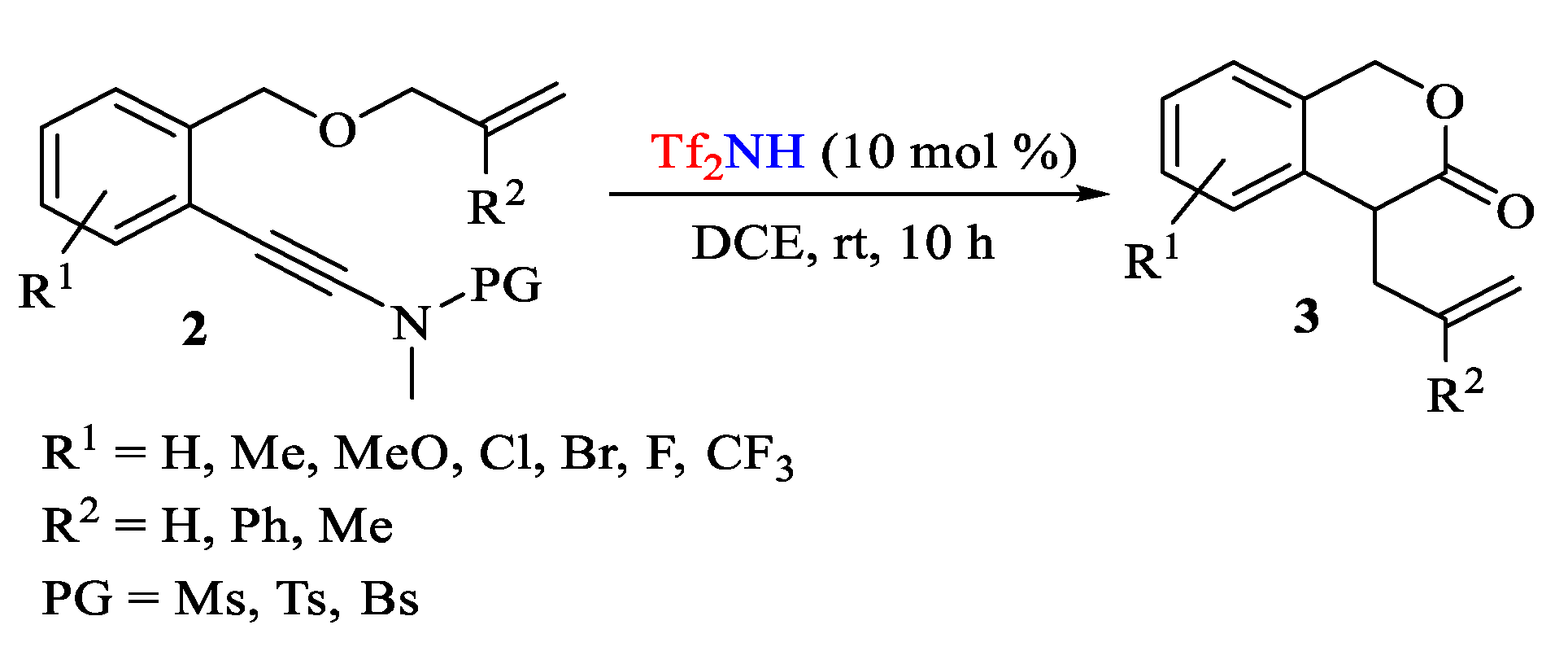
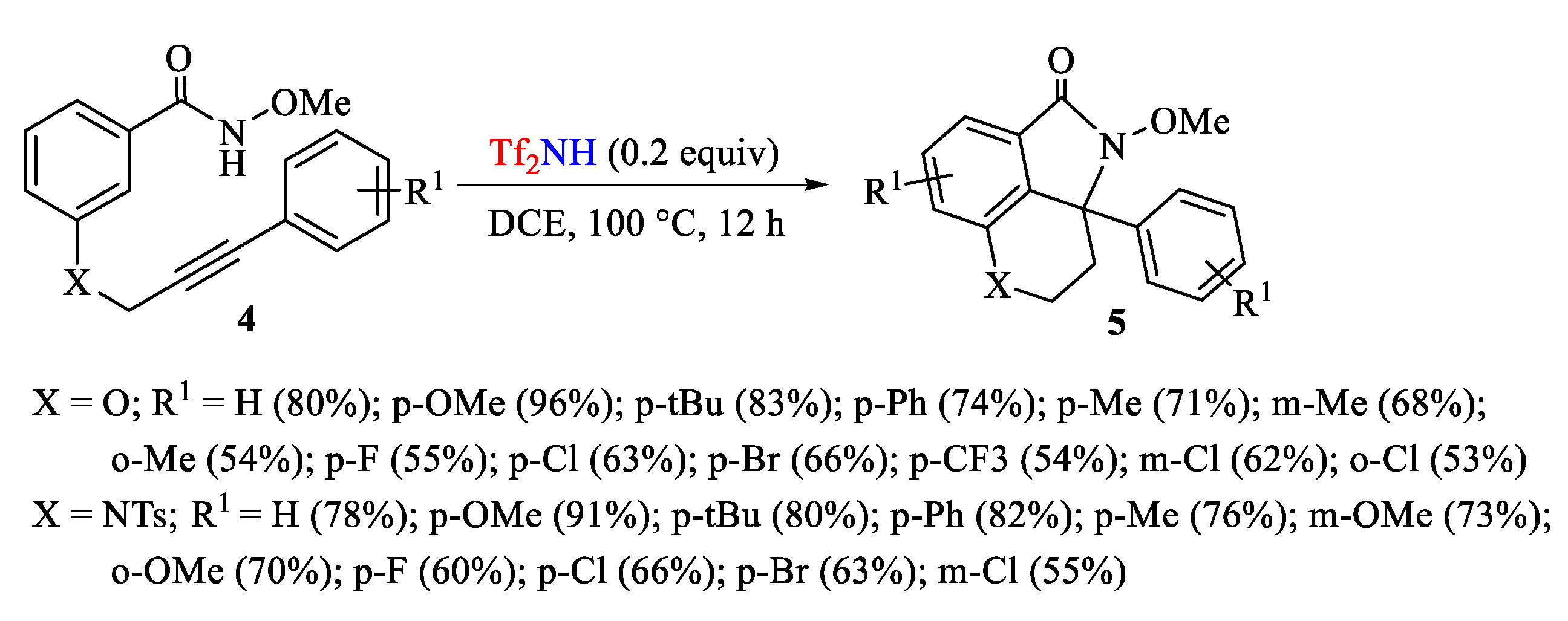







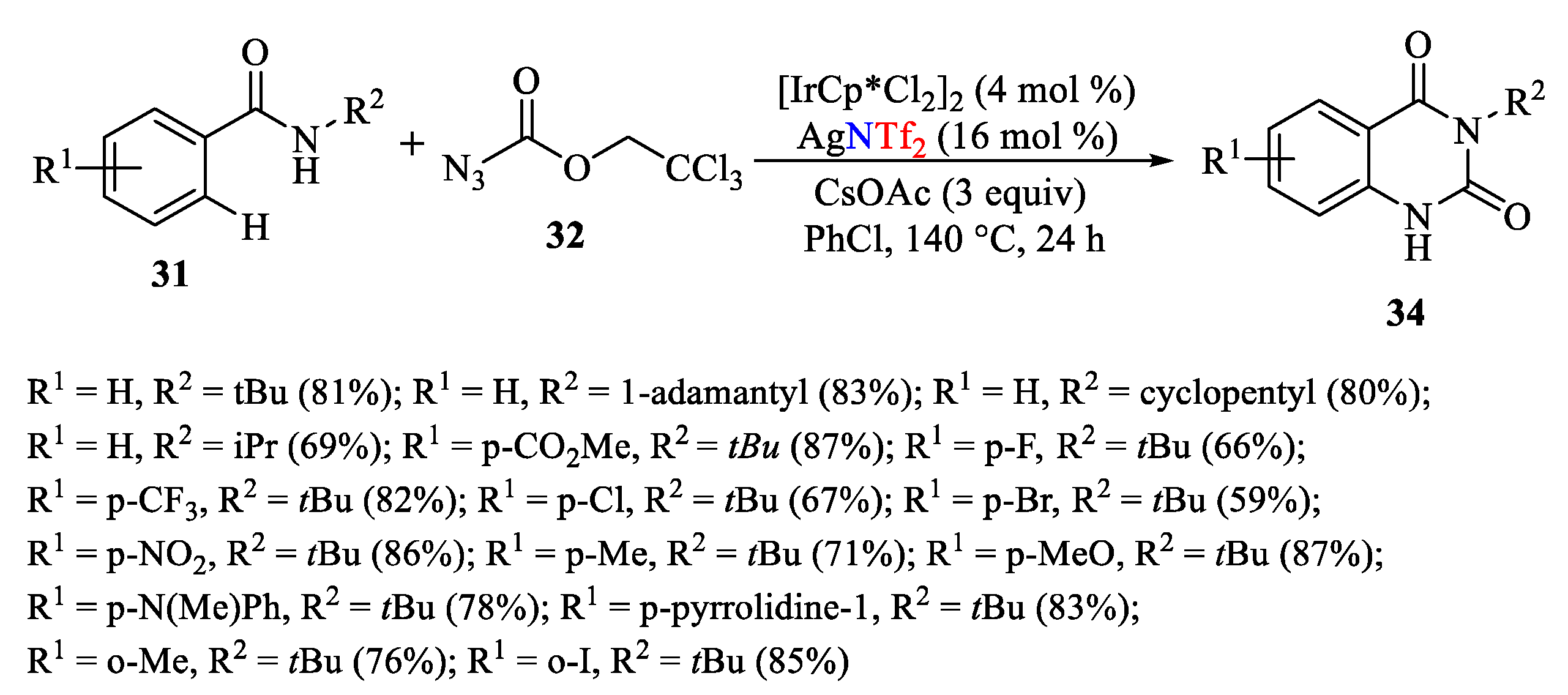
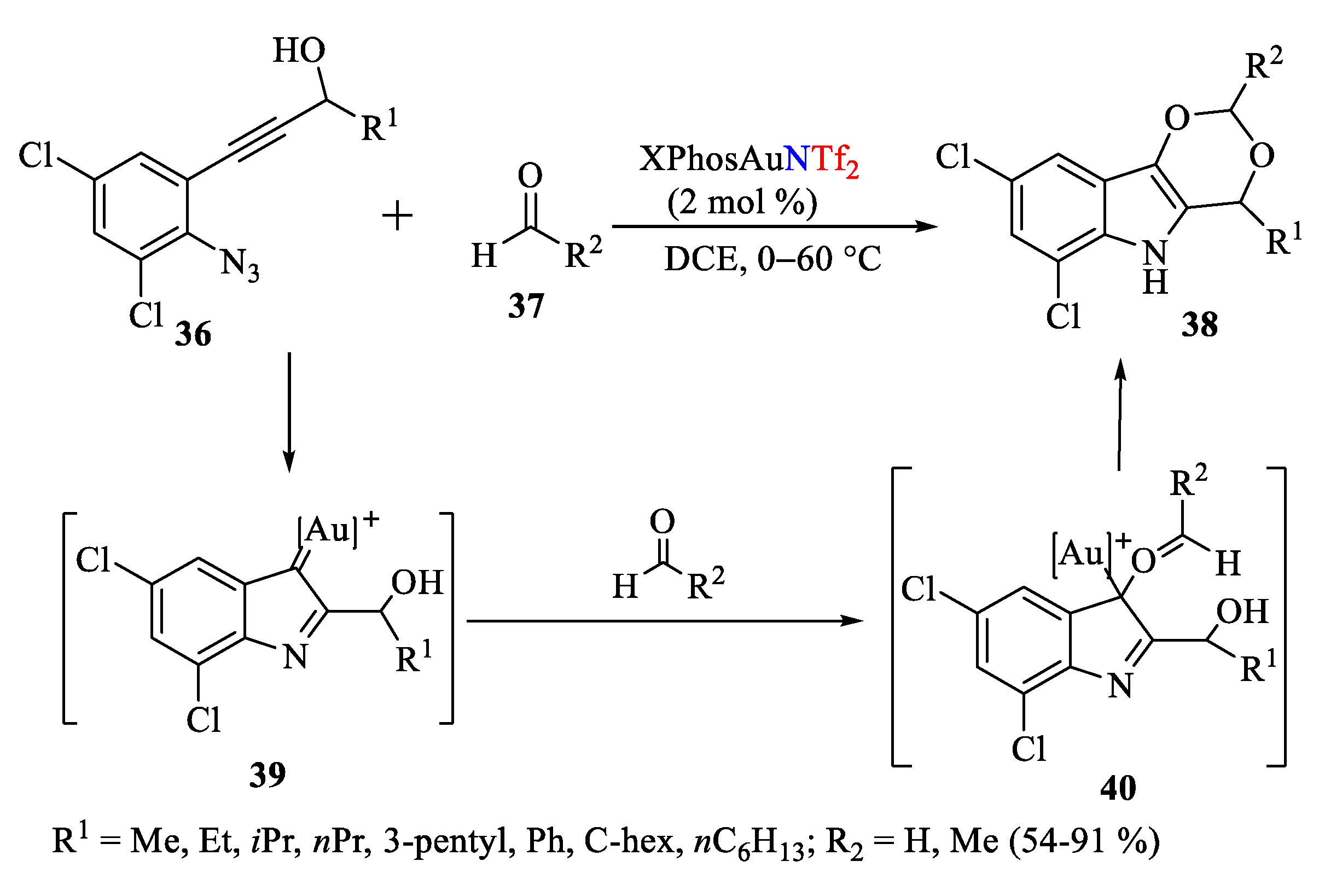

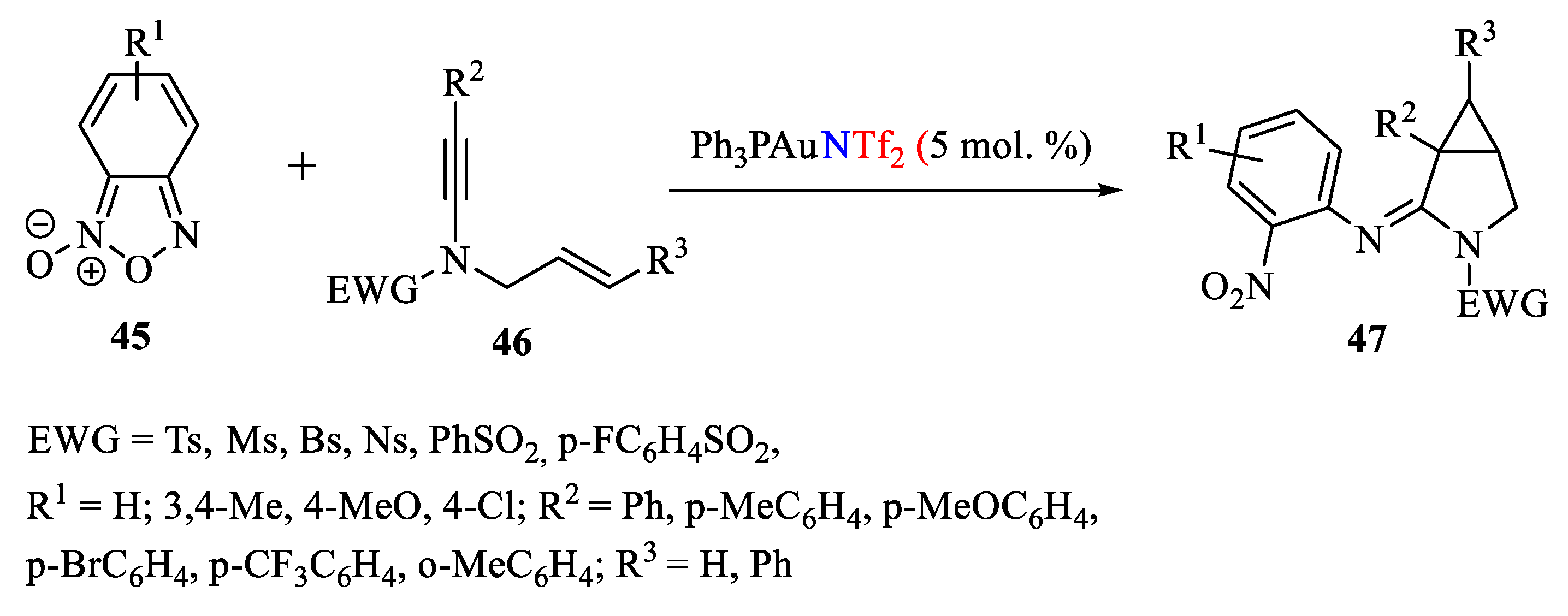
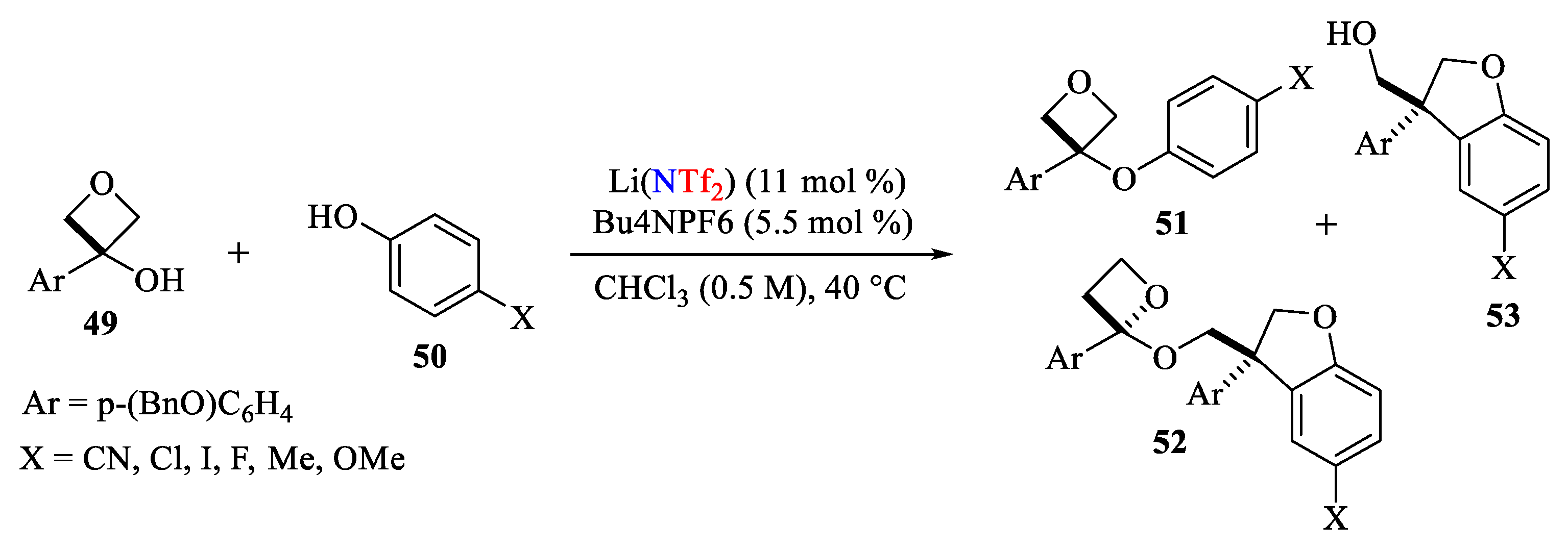







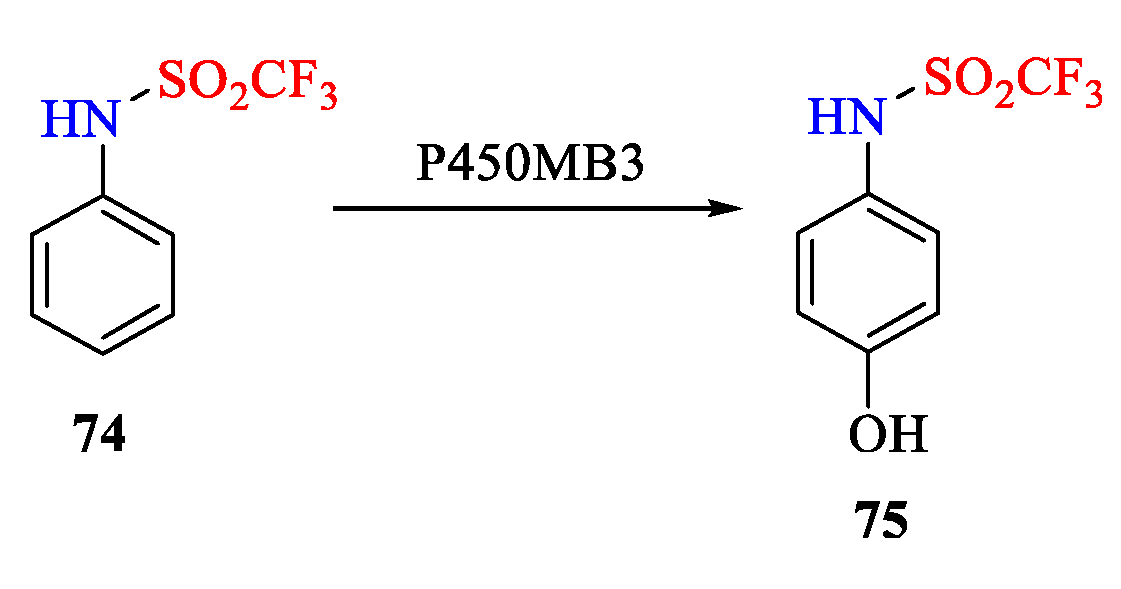

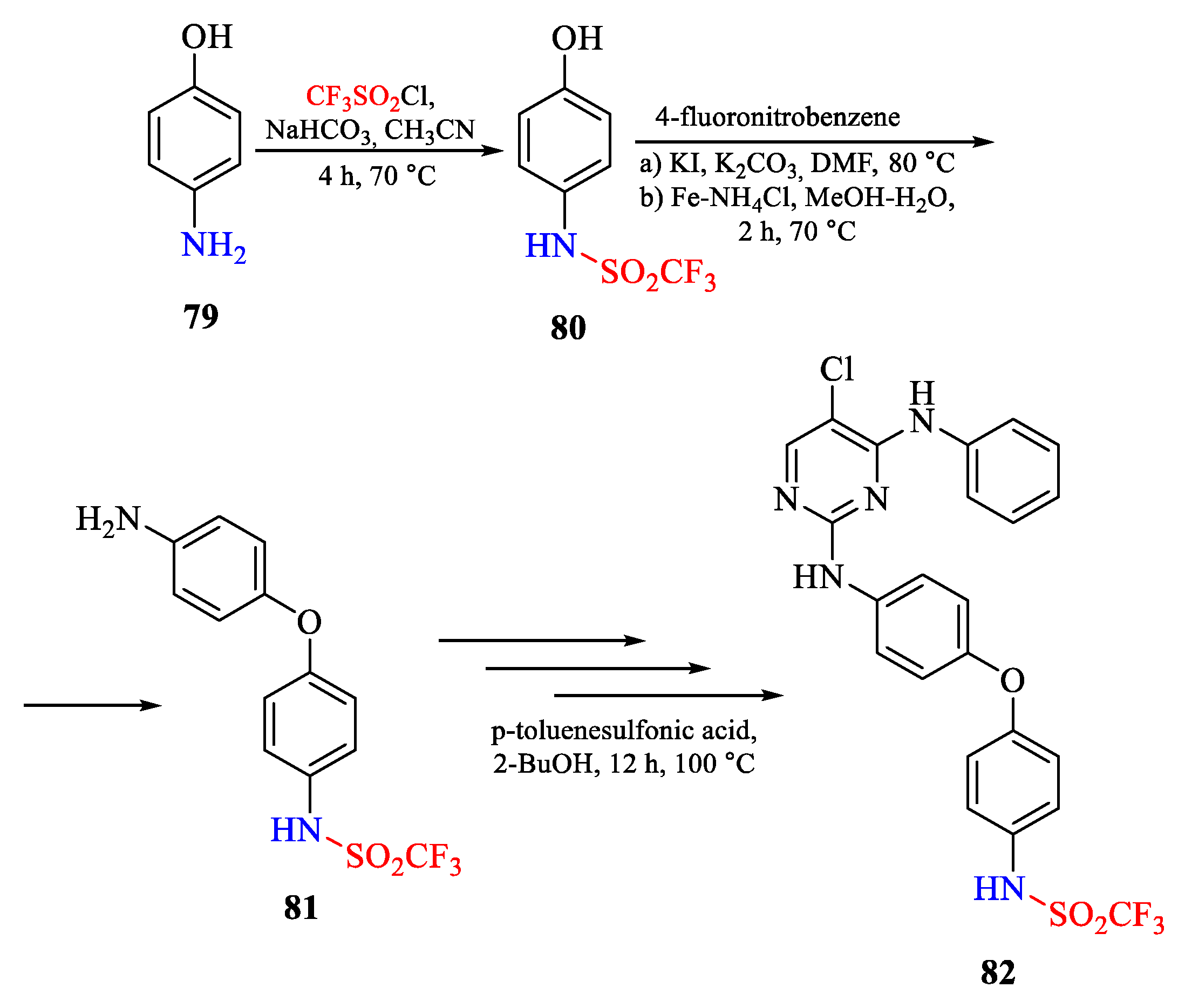
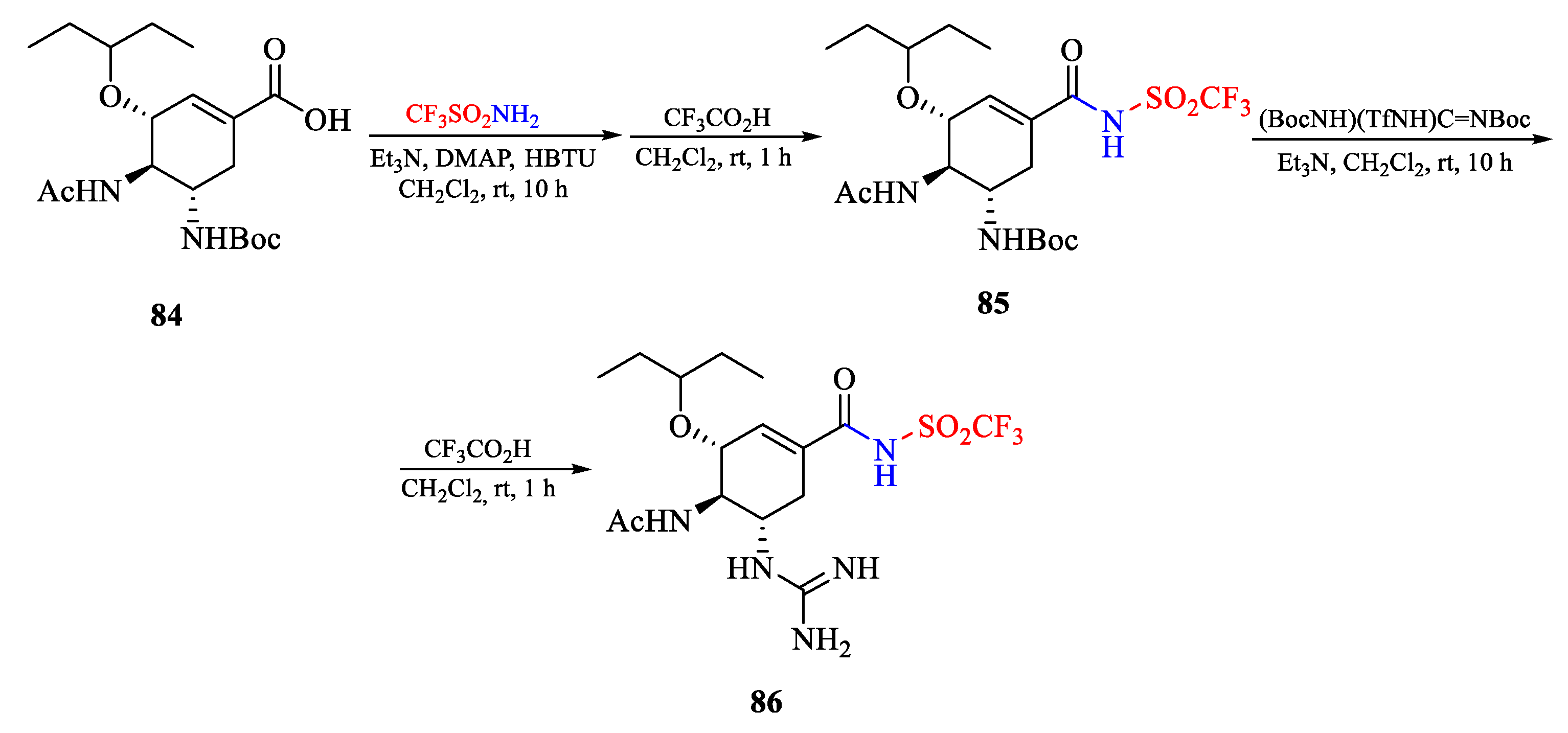
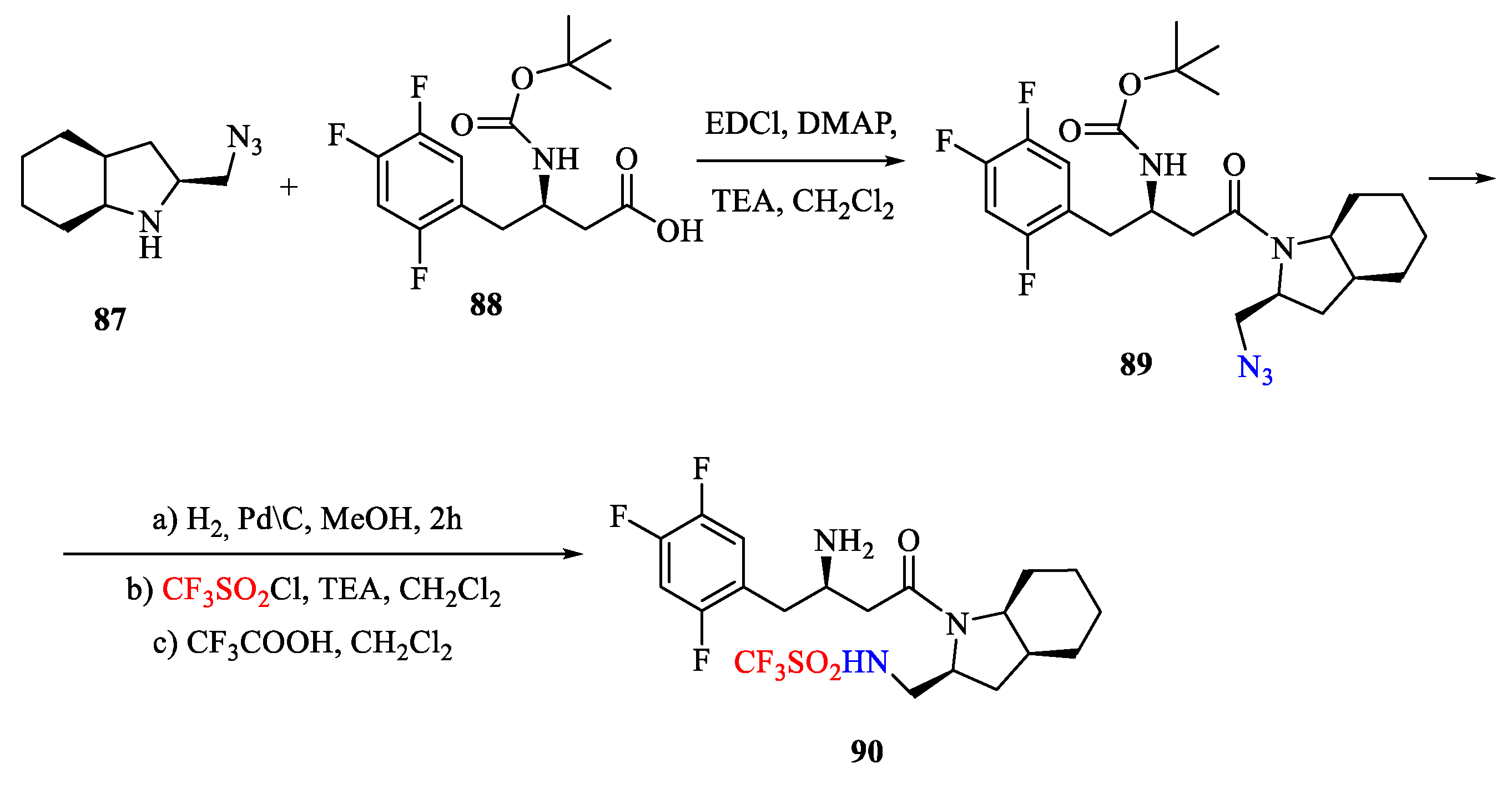


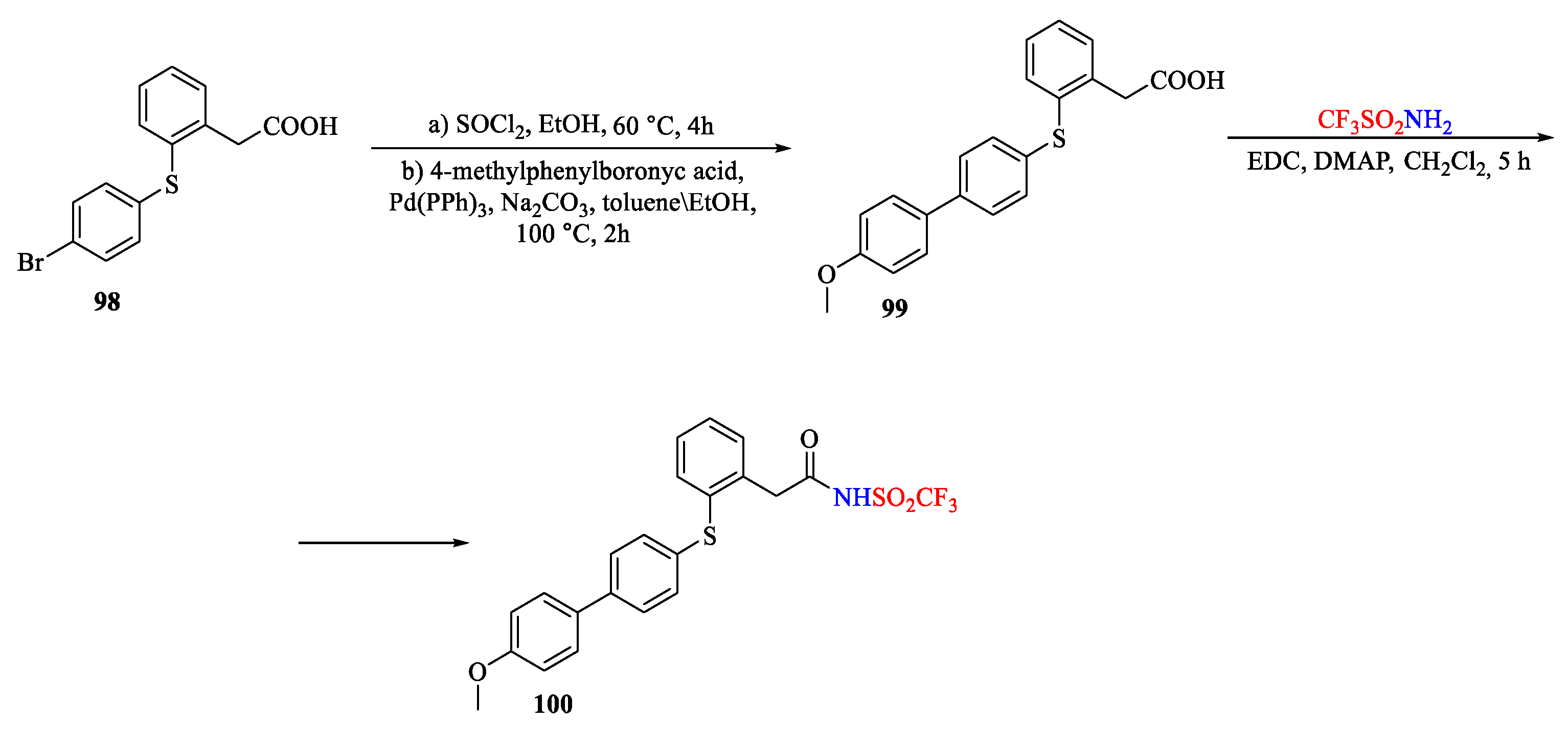
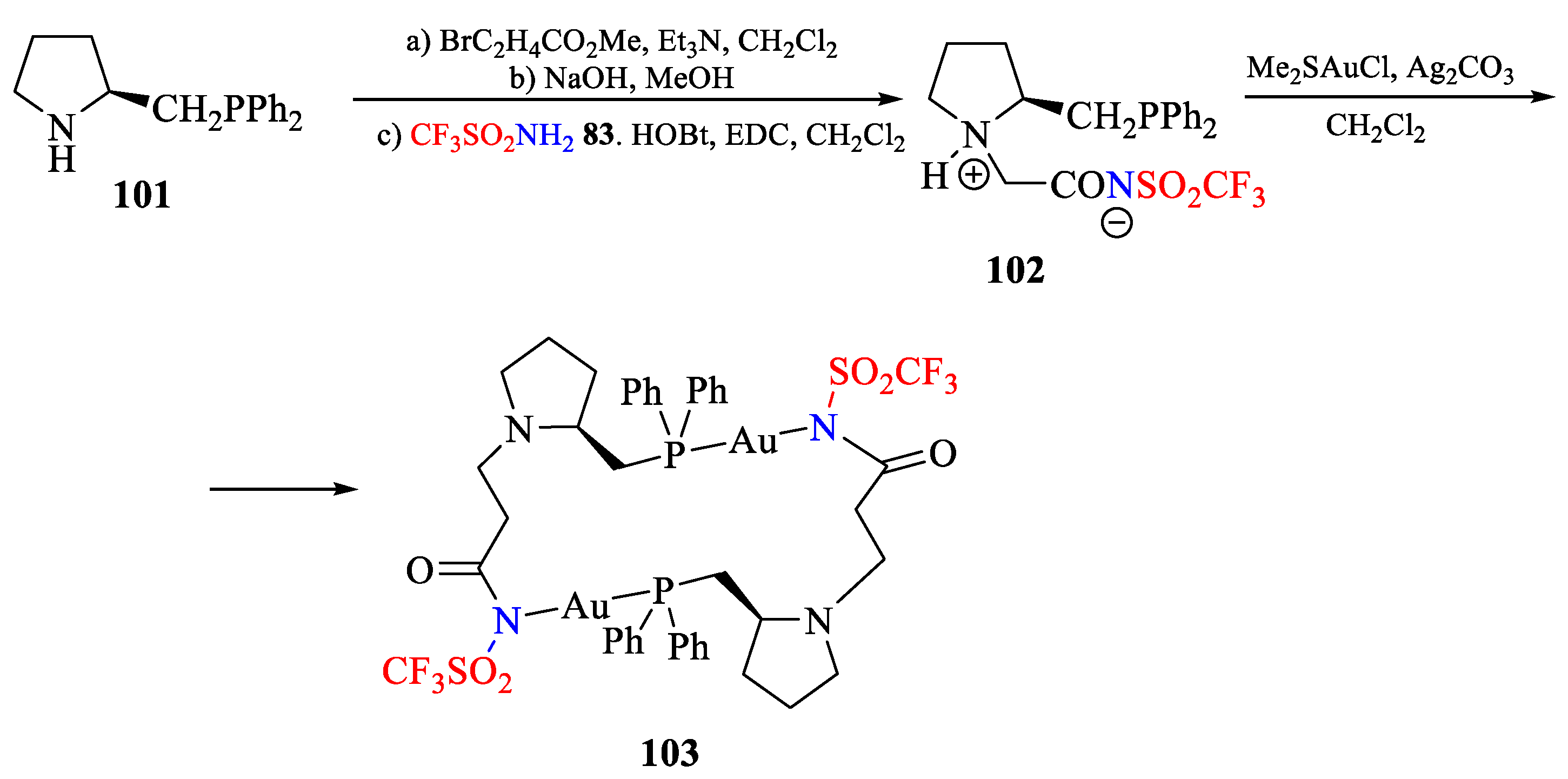


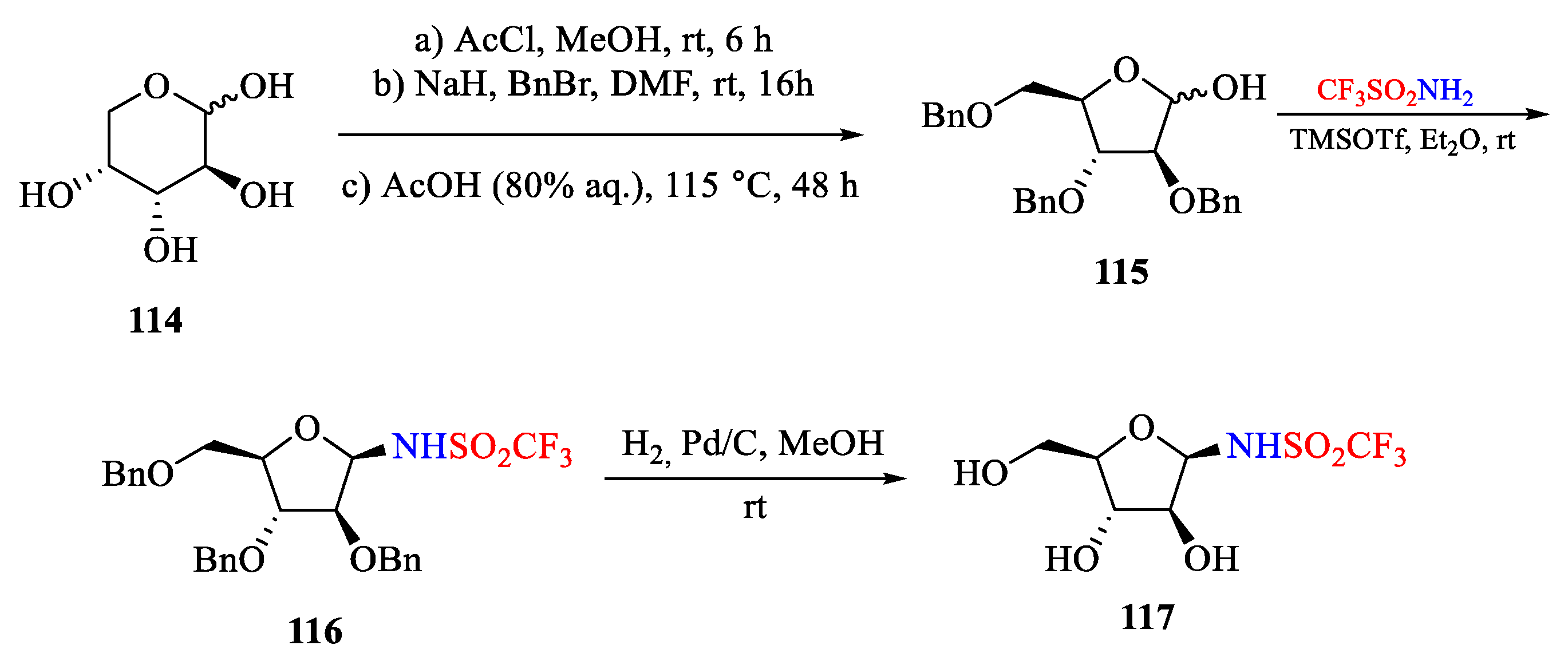
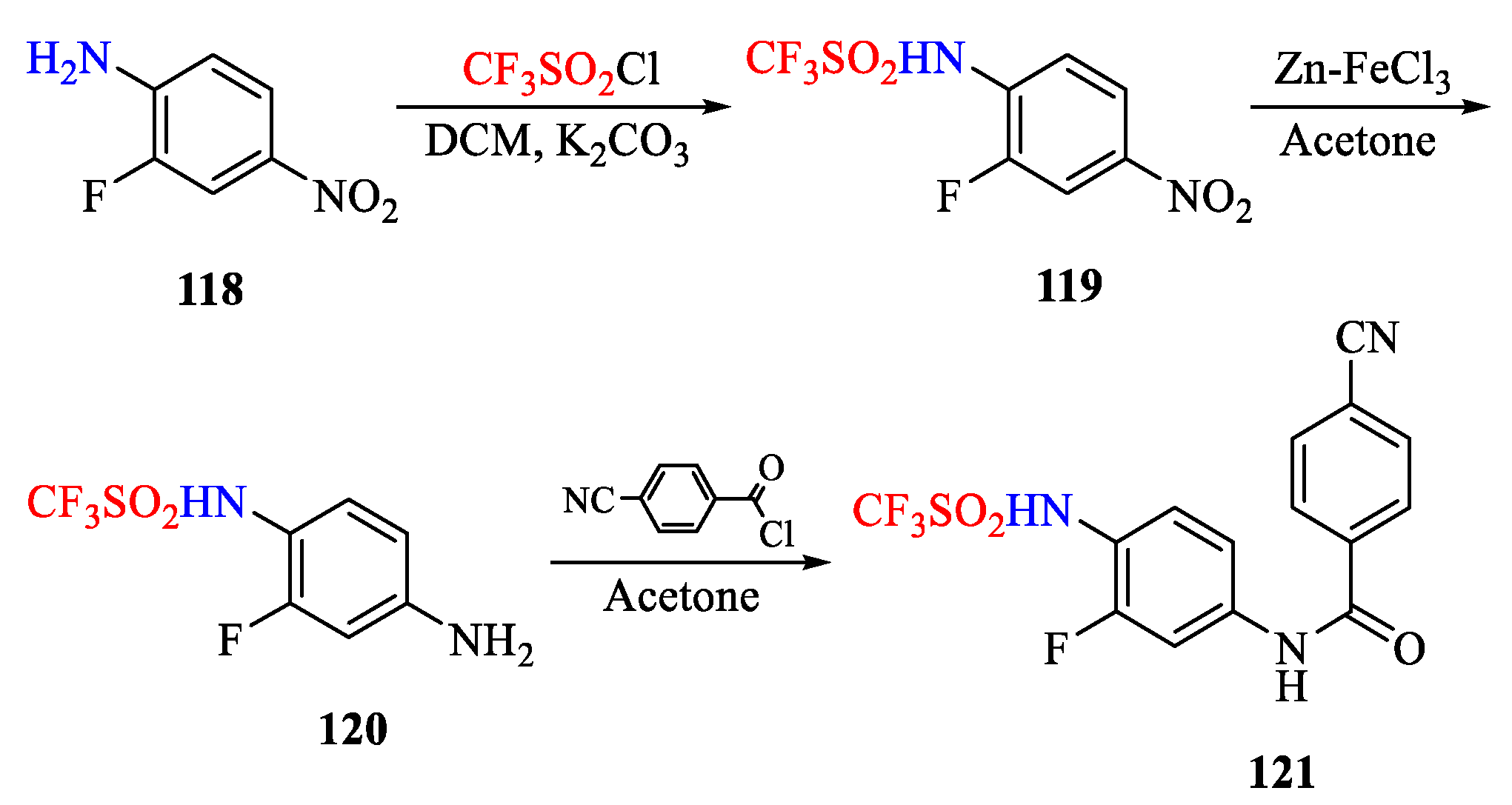
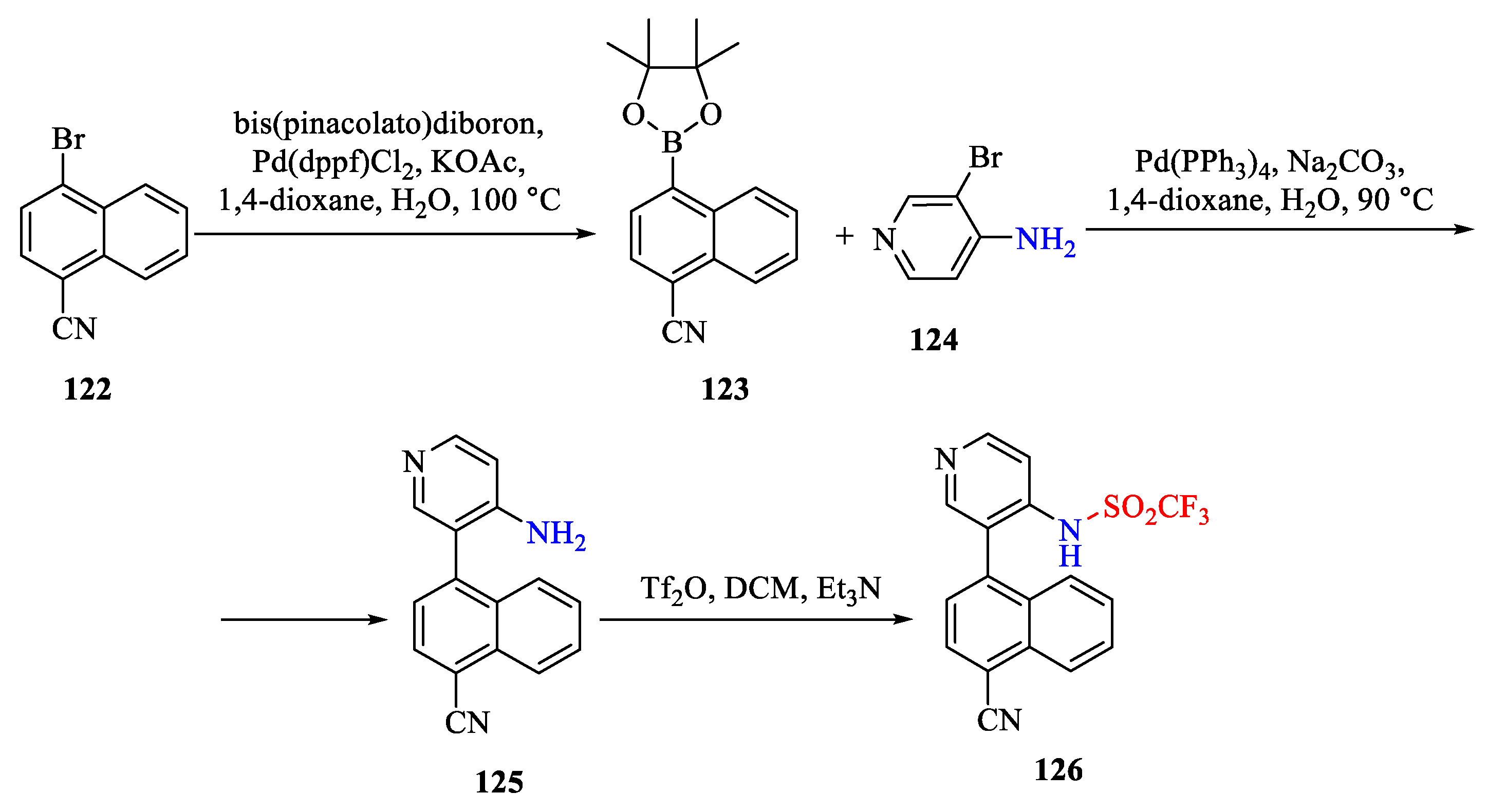
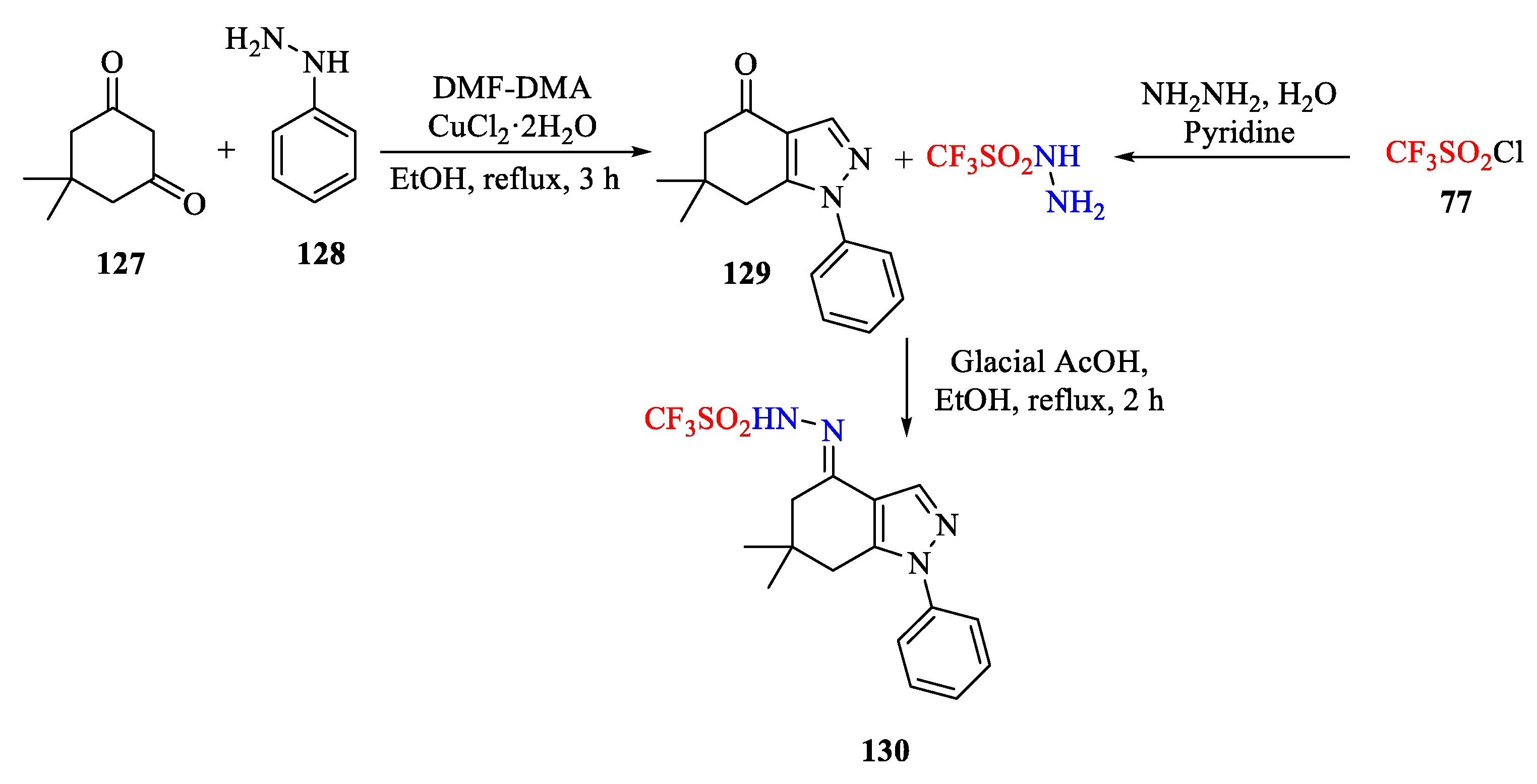
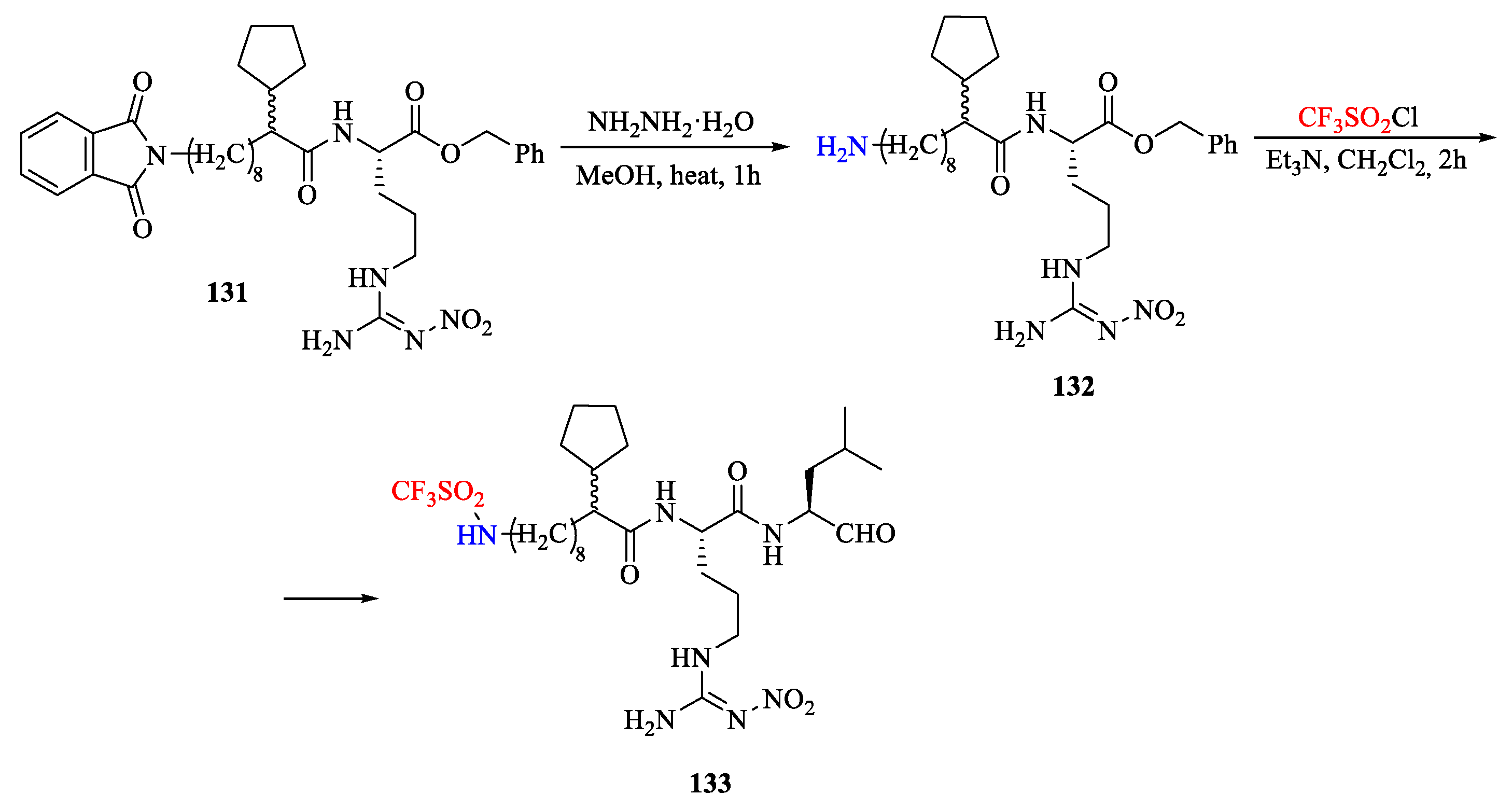




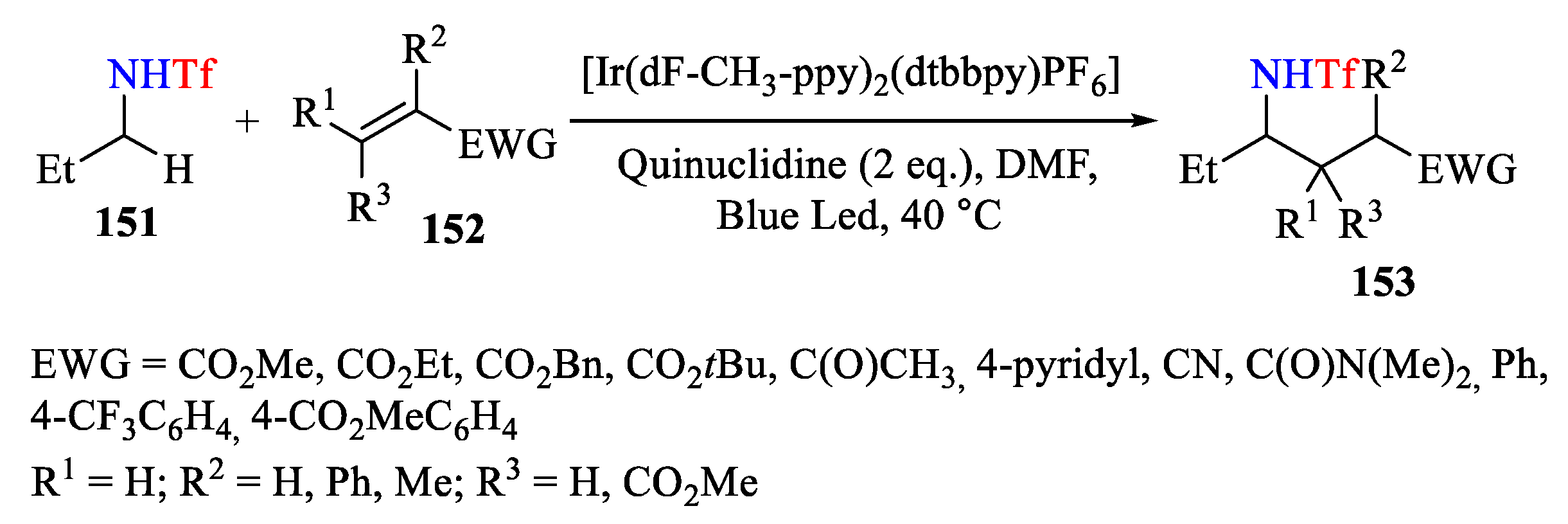


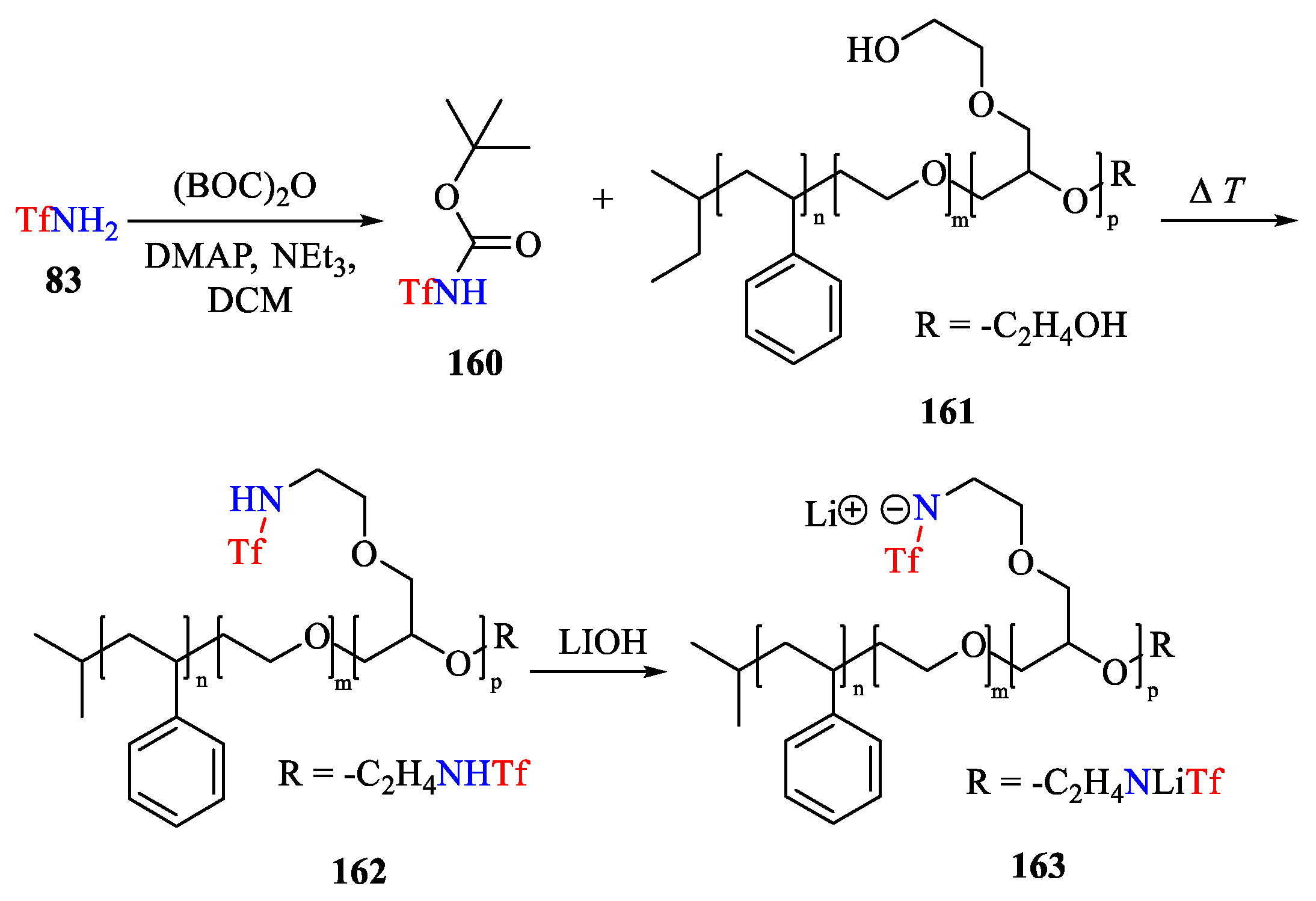




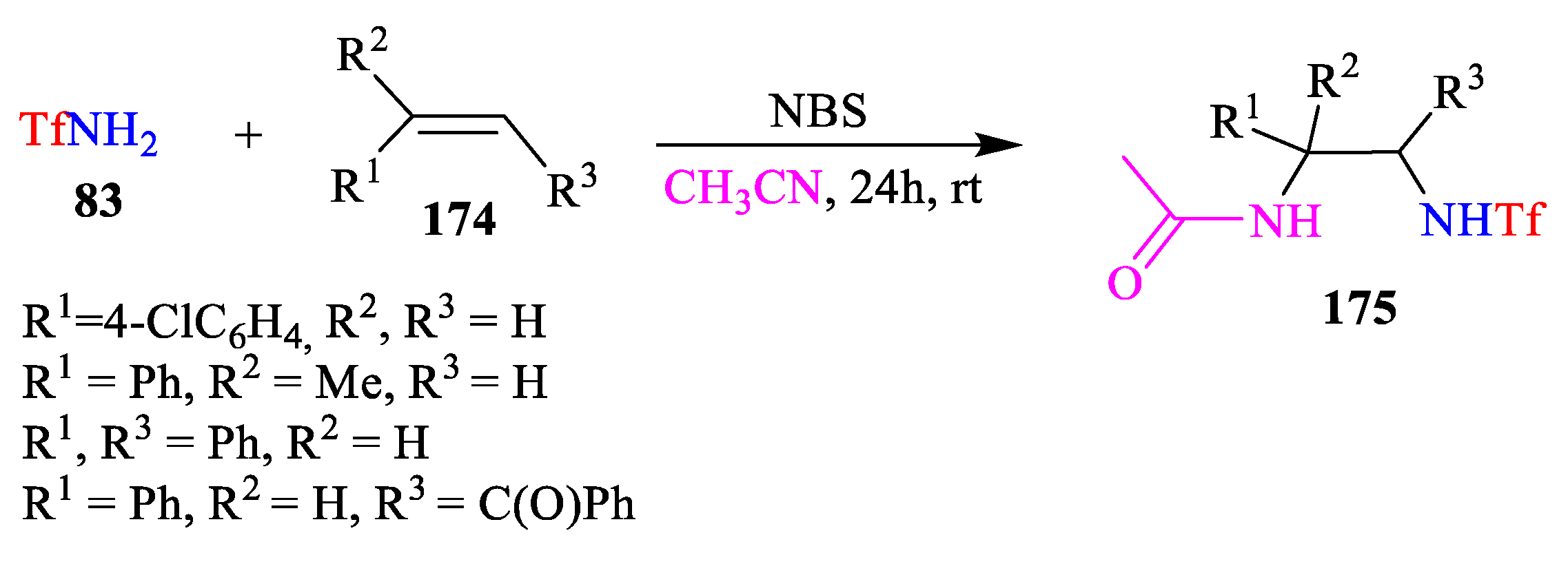





Publisher’s Note: MDPI stays neutral with regard to jurisdictional claims in published maps and institutional affiliations. |
© 2022 by the authors. Licensee MDPI, Basel, Switzerland. This article is an open access article distributed under the terms and conditions of the Creative Commons Attribution (CC BY) license (https://creativecommons.org/licenses/by/4.0/).
Share and Cite
Moskalik, M.Y.; Astakhova, V.V. Triflamides and Triflimides: Synthesis and Applications. Molecules 2022, 27, 5201. https://doi.org/10.3390/molecules27165201
Moskalik MY, Astakhova VV. Triflamides and Triflimides: Synthesis and Applications. Molecules. 2022; 27(16):5201. https://doi.org/10.3390/molecules27165201
Chicago/Turabian StyleMoskalik, Mikhail Y., and Vera V. Astakhova. 2022. "Triflamides and Triflimides: Synthesis and Applications" Molecules 27, no. 16: 5201. https://doi.org/10.3390/molecules27165201
APA StyleMoskalik, M. Y., & Astakhova, V. V. (2022). Triflamides and Triflimides: Synthesis and Applications. Molecules, 27(16), 5201. https://doi.org/10.3390/molecules27165201






